Paul van Yperen's Blog, page 265
July 19, 2018
Ewa Krzyzewska
Polish actress Ewa Krzyzewska (1939–2003) was a beautiful and fascinating star of the East-European cinema in the 1960s. Her most famous film was also her debut, Andrzej Wajda’s masterpiece Popiól i diament/Ashes and Diamonds (1958).
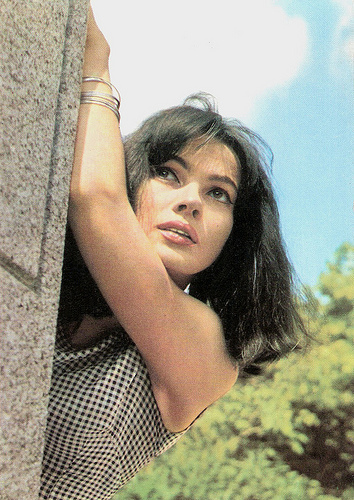
East-German postcard by VEB Progress Filmvertrieb, Berlin, no. 2530, 1966. Retail price: 0,15 MDN. Photo: Balinski.
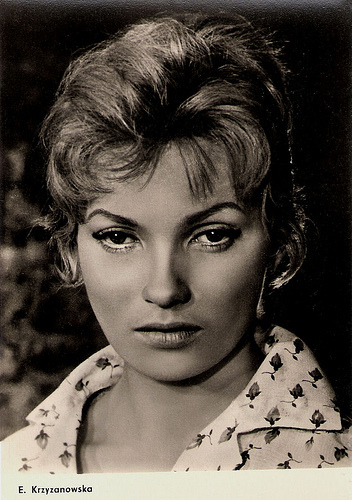
East-German postcard by VEB Progress Filmvertrieb, Berlin, no. 1807, 1963. Retail price: 0,20 DM. Photo: publicity still for Popiól i diament/Ashes and Diamonds (Andrzej Wajda, 1958).
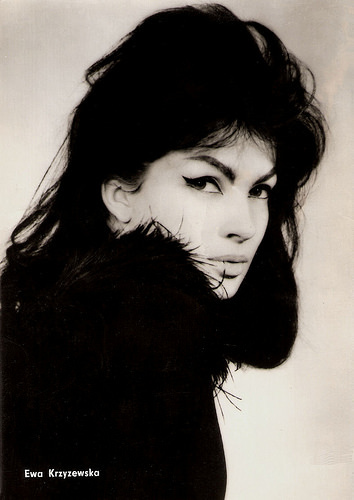
East-German postcard by VEB Progress Filmvertrieb, Berlin, no. 3164, 1968. Photo: Nasterowska.
Atomic War Bride
Ewa Krzyzewska was born as Anna Ewa Krzyżewska-Kwiatkowska in Warszawie (Warsaw), Poland in 1939. Her father was the poet Julius Krzyżewski.
She studied acting at the Państwowe wyższe szkoły teatralne (PWST), the Academy of Dramatic Arts in Krakow. During her first year at the PWST she worked on the film Kalosze szczęścia/Lucky Boots (Antoni Bohdziewicz, 1958).
She was noticed by Janusz Morgenstern, assistant to director Andrzej Wajda. Wajda invited her to play the role of the attractive barmaid Krystyna Rozbicki in his now classic war drama Popiól i diament/Ashes and Diamonds (Andrzej Wajda, 1958).
Popiól i diament, based on the 1948 novel by Polish writer Jerzy Andrzejewski, completed Wajda's war films trilogy, following Pokolenie/A Generation (1954) and Kanal/Sewer (1956).
At AllMovie , Hal Erickson wrote in a now deleted review: “Like most of Polish director Andrzej Wajda's best films, Ashes and Diamonds draws on his personal experiences in the Resistance during World War II. Zbigniew Cybulski , the director's favorite leading man, plays a young underground fighter told to kill a Communist leader on the last day of the war. This blend of idealism and defeatism won numerous awards and brought Wajda international acclaim”.
In 1960 Krzyzewska graduated from the PWST. That year she played a part in the Yugoslavian Science Fiction film Rat/Atomic War Bride (Veljko Bulajic, 1960) about the horrors of the atomic weapon era.
During the early 1960s, she played leading parts in such Polish films as the drama Zaduszki/All Soul’s Day (Tadeusz Konwicki, 1961), the thriller Zbrodniarz i panna/The Criminal and the Lady (Janusz Nasfeter, 1963) again opposite Zbigniew Cybulski , and Zvony pre bosých/ The knell of the tramps (Stanislav Barabas, 1965).
In the Rumanian fantasy-comedy Faust XX (Ion Popescu-Gopo, 1966), she was She-Devil Margueritte, a nightclub singer, who entertains Faust (Emil Botta) and his young assistant ( Iurie Darie ) in the gateway to Hell.
That year she also played a small but memorable role of a beautiful Jewish girl in the historical drama Faraon/Pharaoh (Jerzy Kawalerowicz, 1966) with Jerzy Zelnik as Ramses XIII, and she appeared in the adventure drama Zejscie do piekla/The Descent to Hell (Zbigniew Kuzminski, 1966).
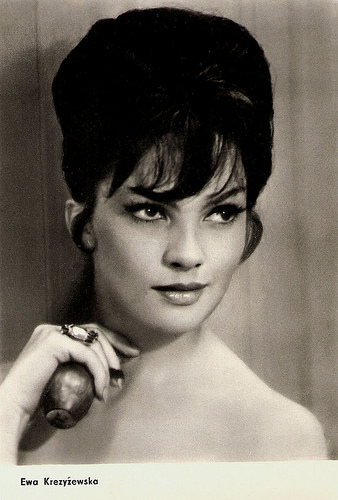
East-German postcard by VEB Progress Filmvertrieb, Berlin, no. 1968, 1963. Photo: publicity still for Zbrodniarz i panna/The Criminal and the Lady (Janusz Nasfeter, 1963).
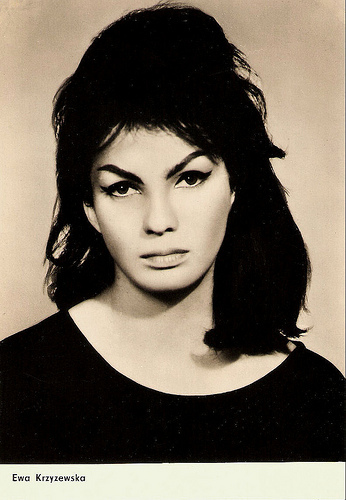
East-German postcard by VEB Progress Filmvertrieb, Berlin, no. 2163, 1964. Retail price: 0,20 MDN.
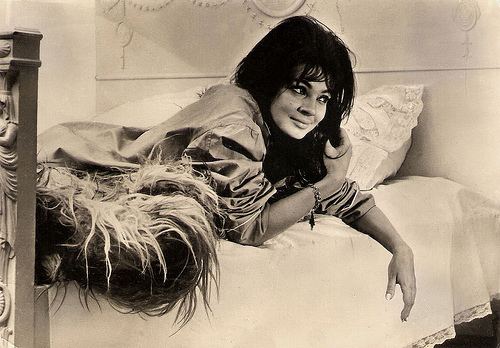
East-German postcard by VEB Progress Filmvertrieb, Berlin, no. 2716, 1966. Retail price: 0,20 MDN.
A Classic Femme Fatale
The introvert Ewa Kryzewska did not like to talk about herself and seldom gave interviews. Therefore she had for many filmgoers a fascinating, mysterious air. In the busy years 1962 - 1967, Krzyzewska was also working on stage for the Teatru Dramatycznego (Warsaw Dramatic Theatre).
But then there was an hiatus in her film and stage career. In 1971 she returned to the cinema in a small role in the drama Akcja 'Brutus'/Operation 'Brutus' (Jerzy Passendorfer, 1971).
That year she also appeared in the romantic comedy Dzieciol/Woodpecker (Jerzy Gruza, 1971) and in East-Germany she played the lead role in Liebeserklärung an G.T./ Declaration of love to G.T. (Horst Seemann, 1971). She also reunited with director Tadeusz Konwicki for the drama Jak daleko stad, jak blisko/How Far, How Near (1972).
Her final film was Zazdrosc i medycyna/Jealousy and medicine (Janusz Majewski, 1973). She played a beautiful, but unfaithful wife of a wealthy entrepreneur (Mariusz Dmochowski)which seemed written especially for her. The film was an acclaimed screen adaptation of a 1930s novel by Michael Choromanski and its heroine was a classic femme fatale, disturbingly and sensually performed by Krzyzewski.
After this sensational turn, Krzyzewska suddenly retired from acting and left Poland with her husband, diplomat Boleslaw Kwiatkowski, a specialist in international law. They lived in several countries, including Syria, Jordan, Kenya, Libya, and Tanzania.
She worked for a short while as the head of the Radio Library at the United Nations Headquarters in New York. In the US she also worked as a beautician, fashion designer, and real estate agent. Later the couple moved to Spain.
In 2003, Ewa Krzyzewska died of the injuries sustained in a car crash in southern Spain. Her husband died on the spot of the car crash. She herself died two days later in a hospital. Ewa Krzyzewska was only 64.
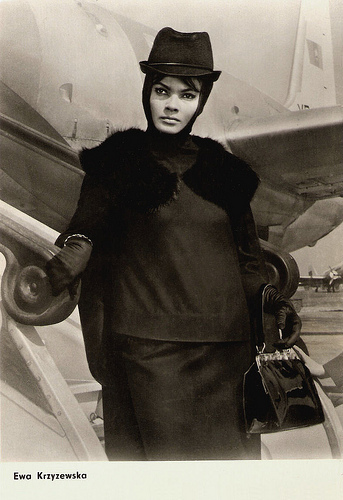
East-German postcard by VEB Progress Filmvertrieb, Berlin, no. 2717, 1966.
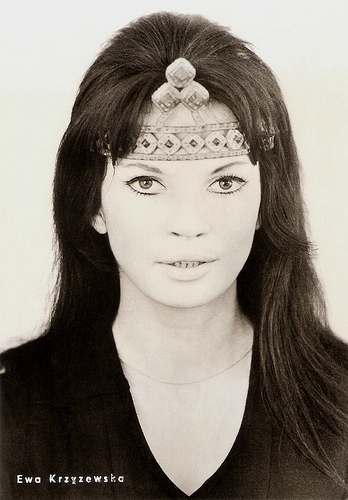
East-German postcard by VEB Progress Filmvertrieb, Berlin, no. 37/71. Retail price: 0,20 M. Photo: Linke.
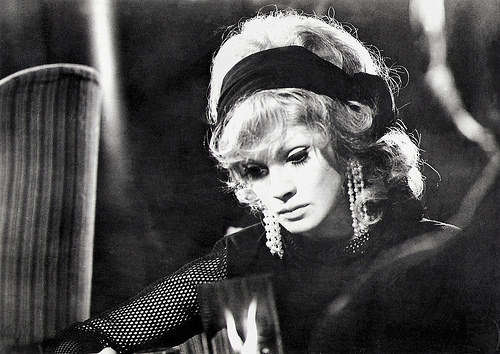
Bulgarian postcard, no. H-3042-A, 1974.
Sources: Hal Erickson (DixClassico), AllMovie, Filmweb.pl (Polish), Wikipedia (Polish) and .

East-German postcard by VEB Progress Filmvertrieb, Berlin, no. 2530, 1966. Retail price: 0,15 MDN. Photo: Balinski.

East-German postcard by VEB Progress Filmvertrieb, Berlin, no. 1807, 1963. Retail price: 0,20 DM. Photo: publicity still for Popiól i diament/Ashes and Diamonds (Andrzej Wajda, 1958).

East-German postcard by VEB Progress Filmvertrieb, Berlin, no. 3164, 1968. Photo: Nasterowska.
Atomic War Bride
Ewa Krzyzewska was born as Anna Ewa Krzyżewska-Kwiatkowska in Warszawie (Warsaw), Poland in 1939. Her father was the poet Julius Krzyżewski.
She studied acting at the Państwowe wyższe szkoły teatralne (PWST), the Academy of Dramatic Arts in Krakow. During her first year at the PWST she worked on the film Kalosze szczęścia/Lucky Boots (Antoni Bohdziewicz, 1958).
She was noticed by Janusz Morgenstern, assistant to director Andrzej Wajda. Wajda invited her to play the role of the attractive barmaid Krystyna Rozbicki in his now classic war drama Popiól i diament/Ashes and Diamonds (Andrzej Wajda, 1958).
Popiól i diament, based on the 1948 novel by Polish writer Jerzy Andrzejewski, completed Wajda's war films trilogy, following Pokolenie/A Generation (1954) and Kanal/Sewer (1956).
At AllMovie , Hal Erickson wrote in a now deleted review: “Like most of Polish director Andrzej Wajda's best films, Ashes and Diamonds draws on his personal experiences in the Resistance during World War II. Zbigniew Cybulski , the director's favorite leading man, plays a young underground fighter told to kill a Communist leader on the last day of the war. This blend of idealism and defeatism won numerous awards and brought Wajda international acclaim”.
In 1960 Krzyzewska graduated from the PWST. That year she played a part in the Yugoslavian Science Fiction film Rat/Atomic War Bride (Veljko Bulajic, 1960) about the horrors of the atomic weapon era.
During the early 1960s, she played leading parts in such Polish films as the drama Zaduszki/All Soul’s Day (Tadeusz Konwicki, 1961), the thriller Zbrodniarz i panna/The Criminal and the Lady (Janusz Nasfeter, 1963) again opposite Zbigniew Cybulski , and Zvony pre bosých/ The knell of the tramps (Stanislav Barabas, 1965).
In the Rumanian fantasy-comedy Faust XX (Ion Popescu-Gopo, 1966), she was She-Devil Margueritte, a nightclub singer, who entertains Faust (Emil Botta) and his young assistant ( Iurie Darie ) in the gateway to Hell.
That year she also played a small but memorable role of a beautiful Jewish girl in the historical drama Faraon/Pharaoh (Jerzy Kawalerowicz, 1966) with Jerzy Zelnik as Ramses XIII, and she appeared in the adventure drama Zejscie do piekla/The Descent to Hell (Zbigniew Kuzminski, 1966).

East-German postcard by VEB Progress Filmvertrieb, Berlin, no. 1968, 1963. Photo: publicity still for Zbrodniarz i panna/The Criminal and the Lady (Janusz Nasfeter, 1963).

East-German postcard by VEB Progress Filmvertrieb, Berlin, no. 2163, 1964. Retail price: 0,20 MDN.

East-German postcard by VEB Progress Filmvertrieb, Berlin, no. 2716, 1966. Retail price: 0,20 MDN.
A Classic Femme Fatale
The introvert Ewa Kryzewska did not like to talk about herself and seldom gave interviews. Therefore she had for many filmgoers a fascinating, mysterious air. In the busy years 1962 - 1967, Krzyzewska was also working on stage for the Teatru Dramatycznego (Warsaw Dramatic Theatre).
But then there was an hiatus in her film and stage career. In 1971 she returned to the cinema in a small role in the drama Akcja 'Brutus'/Operation 'Brutus' (Jerzy Passendorfer, 1971).
That year she also appeared in the romantic comedy Dzieciol/Woodpecker (Jerzy Gruza, 1971) and in East-Germany she played the lead role in Liebeserklärung an G.T./ Declaration of love to G.T. (Horst Seemann, 1971). She also reunited with director Tadeusz Konwicki for the drama Jak daleko stad, jak blisko/How Far, How Near (1972).
Her final film was Zazdrosc i medycyna/Jealousy and medicine (Janusz Majewski, 1973). She played a beautiful, but unfaithful wife of a wealthy entrepreneur (Mariusz Dmochowski)which seemed written especially for her. The film was an acclaimed screen adaptation of a 1930s novel by Michael Choromanski and its heroine was a classic femme fatale, disturbingly and sensually performed by Krzyzewski.
After this sensational turn, Krzyzewska suddenly retired from acting and left Poland with her husband, diplomat Boleslaw Kwiatkowski, a specialist in international law. They lived in several countries, including Syria, Jordan, Kenya, Libya, and Tanzania.
She worked for a short while as the head of the Radio Library at the United Nations Headquarters in New York. In the US she also worked as a beautician, fashion designer, and real estate agent. Later the couple moved to Spain.
In 2003, Ewa Krzyzewska died of the injuries sustained in a car crash in southern Spain. Her husband died on the spot of the car crash. She herself died two days later in a hospital. Ewa Krzyzewska was only 64.

East-German postcard by VEB Progress Filmvertrieb, Berlin, no. 2717, 1966.

East-German postcard by VEB Progress Filmvertrieb, Berlin, no. 37/71. Retail price: 0,20 M. Photo: Linke.

Bulgarian postcard, no. H-3042-A, 1974.
Sources: Hal Erickson (DixClassico), AllMovie, Filmweb.pl (Polish), Wikipedia (Polish) and .
Published on July 19, 2018 22:00
July 18, 2018
New Didier Hanson acquisition: Vera Karalli
My friend Didier Hanson sent me this wonderful postcard, he recently acquired. I love it very much. The picture is a still of one films by Yevgeni Bauer, who directed more than seventy silent films in the four years before the Russian Revolution of 1917. Film critic Kenneth Turan writes in his book on the director: "Bauer's films have been justly called the work of the greatest director you've never heard of." Nabat/The Alarm (1917) was one of the last films Bauer made before he died of pneumonia in a hospital in Yalta, only 52 years old. Star of the film is actress and ballet dancer Vera Karalli of whom Didier Hanson has sent me several postcards in the past. So today a special post on Didier's cards of La Karalli.

Russian postcard, no. 200. Photo: publicity still of Zoya Barantsevich, Vera Karalli , Vladimir Strizhevsky and Vjacheslav Svoboda in Nabat/The Alarm (Yevgeni Bauer, 1917). Collection: Didier Hanson.

Russian postcard. Photo: publicity still for Krizantemy/Chrysanthemums (Pyotr Chardynin, 1914). Collection: Didier Hanson.

Russian postcard, 1916. Collection: Didier Hanson. Eunice and Petronius (1915) was a ballet by choreographer Alexander Alexeyevich Gorsky, produced by the Russian Imperial Ballet.

Russian Postcard, no. 91, 1917. Collection: Didier Hanson.
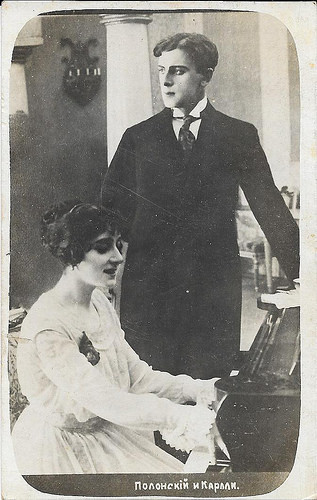
Russian postcard. Collection: Didier Hanson. Photo: publicity still for Vozmezdie/Retribution (Yevgeni Bauer, 1916) with Vitold Polonsky .

Russian Postcard, no. 152. Collection: Didier Hanson. Photo: publicity still for Vozmezdie/Retribution (Yevgeni Bauer, 1916) with Lidya F. Ryndina , Vera Karalli and Vitold Polonsky .
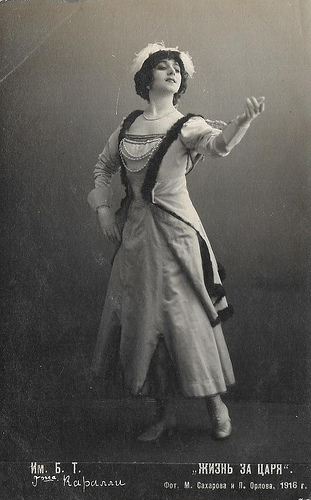
Russian postcard, 1916. Collection: Didier Hanson.
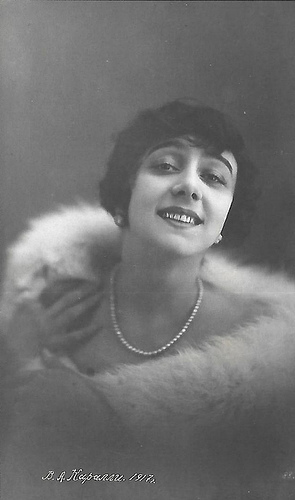
Russian postcard, 1917. Collection: Didier Hanson.
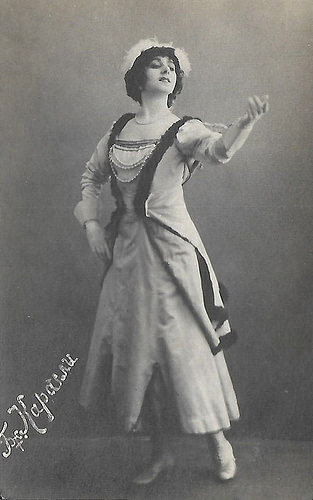
Russian postcard. Collection: Didier Hanson.
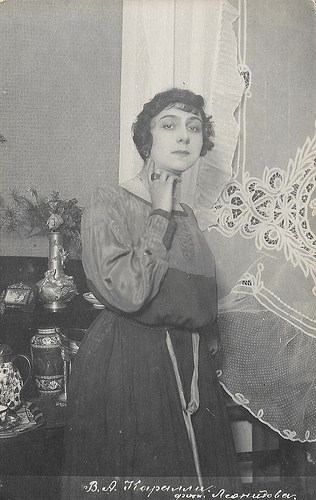
Russian postcard. Collection: Didier Hanson.
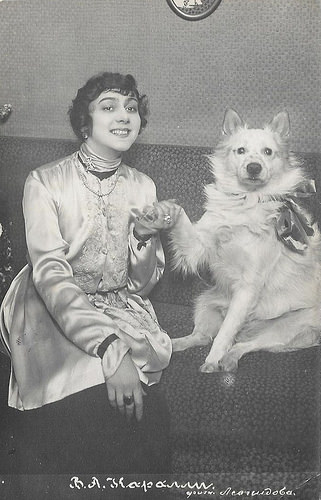
Russian postcard. Collection: Didier Hanson.
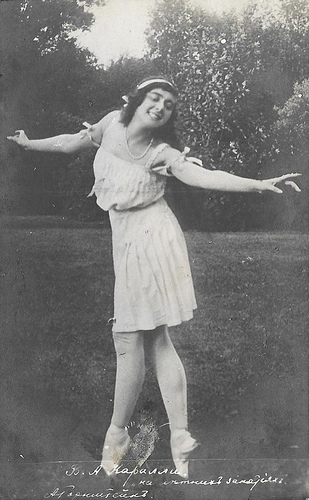
Russian postcard. Collection: Didier Hanson.
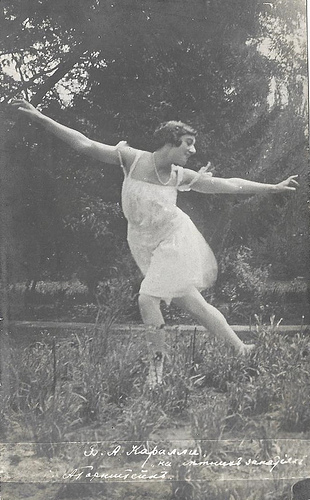
Russian postcard. Collection: Didier Hanson.
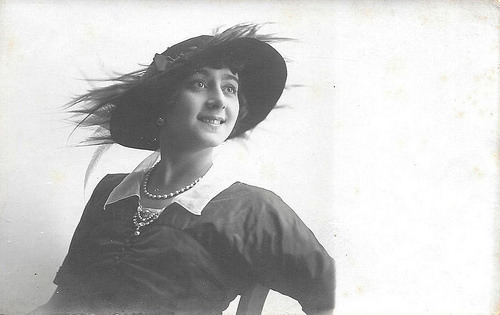
Russian postcard. Collection: Didier Hanson.
Sources: Kenneth Turan (LA Times), Wikipedia and IMDb.

Russian postcard, no. 200. Photo: publicity still of Zoya Barantsevich, Vera Karalli , Vladimir Strizhevsky and Vjacheslav Svoboda in Nabat/The Alarm (Yevgeni Bauer, 1917). Collection: Didier Hanson.

Russian postcard. Photo: publicity still for Krizantemy/Chrysanthemums (Pyotr Chardynin, 1914). Collection: Didier Hanson.

Russian postcard, 1916. Collection: Didier Hanson. Eunice and Petronius (1915) was a ballet by choreographer Alexander Alexeyevich Gorsky, produced by the Russian Imperial Ballet.

Russian Postcard, no. 91, 1917. Collection: Didier Hanson.

Russian postcard. Collection: Didier Hanson. Photo: publicity still for Vozmezdie/Retribution (Yevgeni Bauer, 1916) with Vitold Polonsky .

Russian Postcard, no. 152. Collection: Didier Hanson. Photo: publicity still for Vozmezdie/Retribution (Yevgeni Bauer, 1916) with Lidya F. Ryndina , Vera Karalli and Vitold Polonsky .

Russian postcard, 1916. Collection: Didier Hanson.

Russian postcard, 1917. Collection: Didier Hanson.

Russian postcard. Collection: Didier Hanson.

Russian postcard. Collection: Didier Hanson.

Russian postcard. Collection: Didier Hanson.

Russian postcard. Collection: Didier Hanson.

Russian postcard. Collection: Didier Hanson.

Russian postcard. Collection: Didier Hanson.
Sources: Kenneth Turan (LA Times), Wikipedia and IMDb.
Published on July 18, 2018 22:00
July 17, 2018
Mara Lane
British-Austrian actress Mara Lane (1930) was considered one of the most beautiful models in Great Britain during the early 1950s. She appeared in more than 30 English and German language films of the 1950s and early 1960s, but she seems forgotten now.
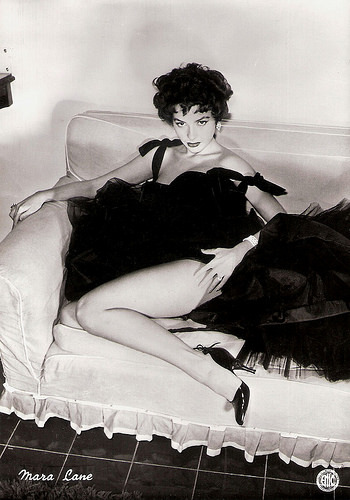
Italian postcard by Bromofoto, Milano, no. 968. Photo: ENIC.
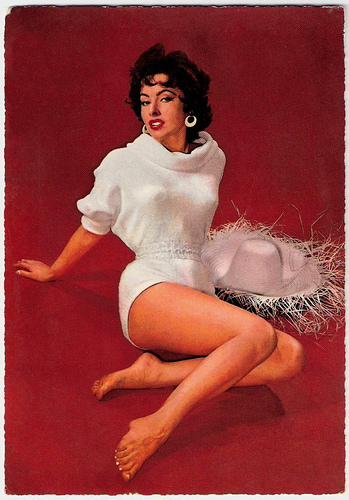
German postcard by Krüger, no. 902/58.
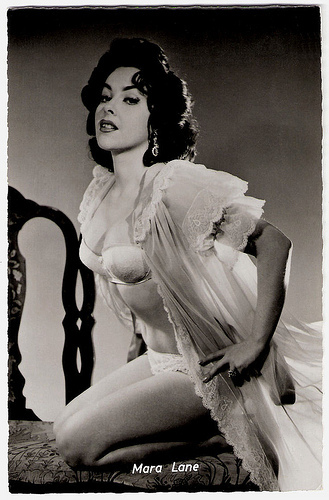
German postcard by Kolibri-Verlag G.m.bH., Minden-Westf., no. 1828.
Cover Model
Mara Lane was born as Dorothy Lane Bolton in 1930, in Vienna, Austria. Her mother was Russian-born pianist Olga Mironova and her English father Briton John Bolton worked in Vienna for an American oil firm. Her father later died in a car crash in the U.S.
Her younger sister, Jacelyn Olga, later became known as actress Jackie Lane (aka Jocelyn Lane).
In Vienna Mara trained for the Viennese ballet, but her family left Austria and in 1942 they arrived aboard the Jutlandia in New York from Copenhagen, Denmark. In New York she attended high school.
In 1950, she moved to London, England, to study dress design. She is soon spotted by a talent scout in a restaurant.
In the early 1950s, Mara became a glamorous and very popular cover model in Great Britain. The Elizabeth Taylor -like beauty was soon also discovered for the cinema.
In 1951, she made her film debut as a cafe singer in Hell Is Sold Out (Michael Anderson, 1951) starring Mai Zetterling .
Other small roles followed in the comedy Treasure Hunt (John Paddy Carstairs, 1952) and in the comedy-drama Something Money Can't Buy (Pat Jackson, 1952) starring Patricia Roc .
Her first bigger part was in Decameron Nights (Hugo Fregonese, 1953), a rather dull adaptation of Giovanni Boccaccio’s bawdy novel.
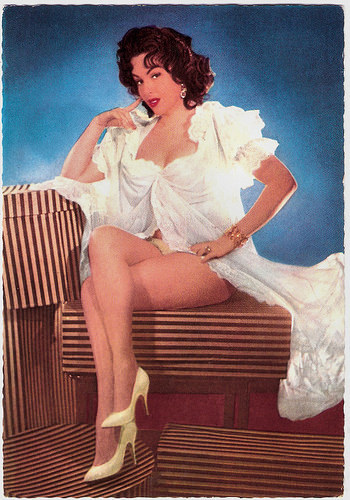
Dutch postcard by P. Moorlag, Heerlen, Sort. 13/6.

Dutch postcard by P. Moorlag, Heerlen, Sort. 15/6.
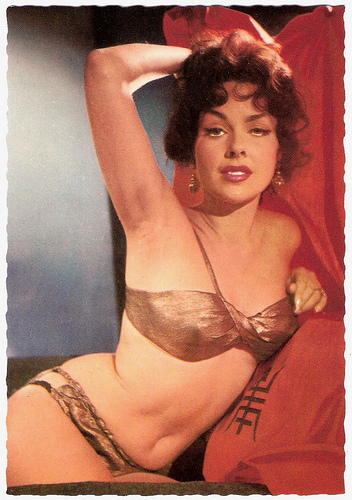
German postcard by ISV, Sort. 16/6.
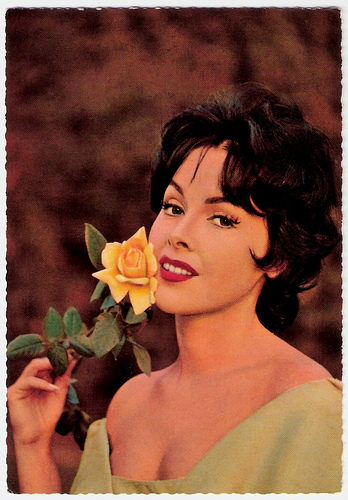
German postcard by Krüger, no. 902/68. Photo: Bernard of Hollywood.
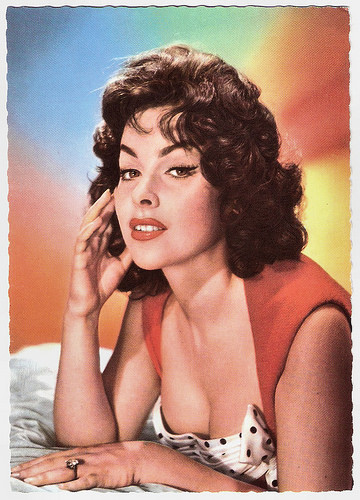
German postcard by Ufa, Berlin-Tempelhof, no. CK-308. Photo: Joe Niczky / UFA.
Sultry Femme Fatale
Later that year, she went to Hollywood, like her sister Jackie would do a few years later. There she was a popular and often photographed starlet.
Howard Hughes’ RKO signed her for a Hollywood contract. She played a supporting part in the comedy Susan Slept Here (Frank Tashlin, 1954) and starred as a sultry femme fatale in Angela (Edoardo Anton, Dennis O'Keefe, 1954).
While filming Angela (Edoardo Anton, Dennis O'Keefe, 1954) in Italy she caught the eye of wealthy Italian prince Alessandro 'Dado' Ruspoli. Reportedly, he tried to get his passport back so that he could travel to Switzerland to divorce his Princess Francesca and marry Mara. However, a wedding never occurred.
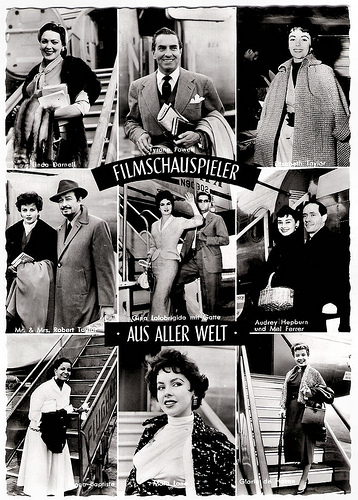
German postcard by Kunst und Film Verlag H. Lukow, Hannover, no. L2/1042. Caption: Filmschauspieler aus aller Welt (Film actors from around the world). Mara Lane in the middle below.
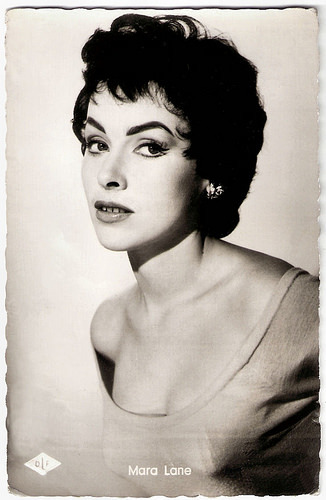
West-German postcard by Kolibri-Verlag, Minden/Westf., no. 2318. Photo: Melodie / Deutsche London (DLF) / Heil. Publicity still for Bonsoir Paris/Good Evening Paris (Ralph Baum, 1956).
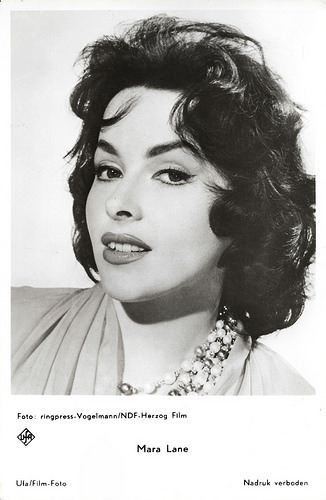
Dutch-Belgian postcard by DRC Holland, no. 3673. Photo: Ringpress / Vogelmann / NDF / Herzog Film / Ufa.
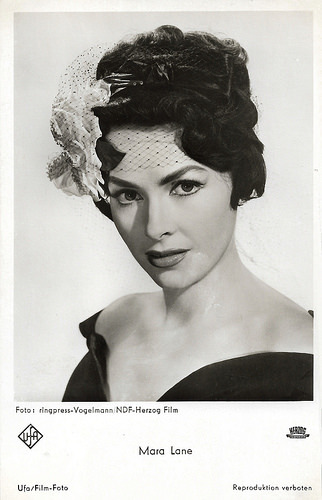
West-German postcard by Ufa/Film-Foto, Berlin-Tempelhof, no. FK 3674. Photo: Ringpress / Vogelmann / NDF / Herzog Film. Publicity still for Monpti/Love from Paris (Helmut Käutner, 1957).
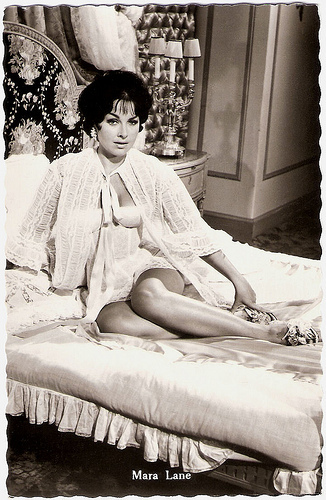
German postcard, no. 961.
Sexy Eye CandyIn 1954, Mara Lane returned to Europe to reprise her film career here. She appeared in Italy in La grande avventura/The Great Adventure (Mario Pisu, 1954) with Gino Cervi, and Le avventure di Giacomo Casanova/Sins of Casanova (Steno, 1955).
Lane was mainly cast as sexy eye candy in European comedies like the the French comedy Bonsoir Paris (Ralph Baum, 1956) with Dany Robin , and the German comedy Der Fremdenführer von Lissabon/The Guide of Lisbon (Hans Deppe, 1956) starring Vico Torriani .
One of her better films was Monpti/Love From Paris (Helmut Käutner, 1957), in which she supported Romy Schneider and Horst Buchholz .
After that she appeared in more than a dozen European B-films, including German comedies, Italian Peplums and a Spanish drama, but all of no interest.
In 1961, she married petrol millionair William Dugger from San Antonio, Texas, in a civil ceremony in London. She left him after three years.
In 1965 Mara Lane retired. Her films are mostly forgotten now, but her pin-up pictures are still popular on the net.
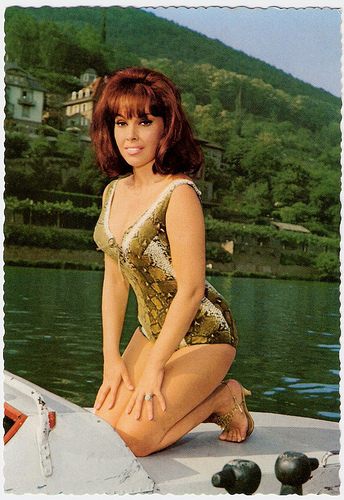
German postcard by ISV, Sort. 17/6.
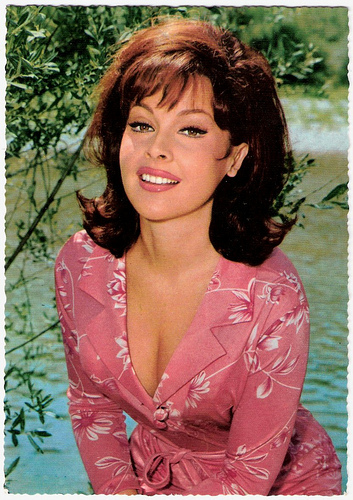
German postcard by Krüger, no. 902/406. Photo: Erwin Schneider.

German postcard by ISV, Sort. 14/6.
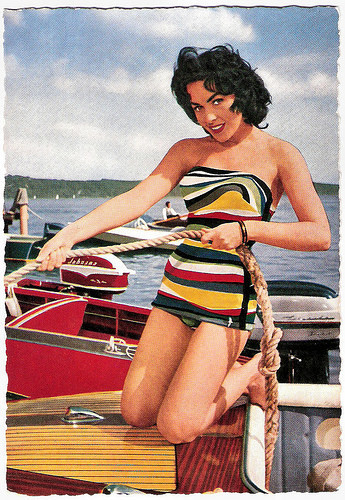
German postcard by WS-Druck, Wanne-Eickel, no. F-80. Photo: Klaus Collignon / UFA.
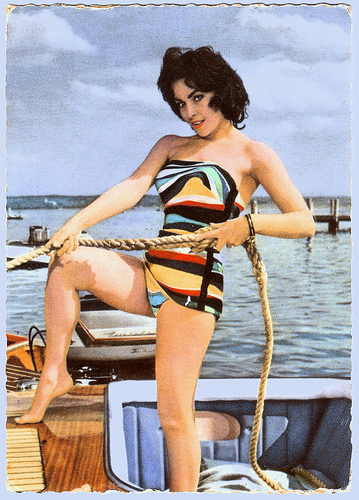
German postcard by UFA, no. CK-200. Photo: Klaus Collignon / UFA.
Sources: Celine Colassin (La saga des etoiles filantes - French), Glamour Girls of the Silver Screen, Wikipedia and .

Italian postcard by Bromofoto, Milano, no. 968. Photo: ENIC.

German postcard by Krüger, no. 902/58.

German postcard by Kolibri-Verlag G.m.bH., Minden-Westf., no. 1828.
Cover Model
Mara Lane was born as Dorothy Lane Bolton in 1930, in Vienna, Austria. Her mother was Russian-born pianist Olga Mironova and her English father Briton John Bolton worked in Vienna for an American oil firm. Her father later died in a car crash in the U.S.
Her younger sister, Jacelyn Olga, later became known as actress Jackie Lane (aka Jocelyn Lane).
In Vienna Mara trained for the Viennese ballet, but her family left Austria and in 1942 they arrived aboard the Jutlandia in New York from Copenhagen, Denmark. In New York she attended high school.
In 1950, she moved to London, England, to study dress design. She is soon spotted by a talent scout in a restaurant.
In the early 1950s, Mara became a glamorous and very popular cover model in Great Britain. The Elizabeth Taylor -like beauty was soon also discovered for the cinema.
In 1951, she made her film debut as a cafe singer in Hell Is Sold Out (Michael Anderson, 1951) starring Mai Zetterling .
Other small roles followed in the comedy Treasure Hunt (John Paddy Carstairs, 1952) and in the comedy-drama Something Money Can't Buy (Pat Jackson, 1952) starring Patricia Roc .
Her first bigger part was in Decameron Nights (Hugo Fregonese, 1953), a rather dull adaptation of Giovanni Boccaccio’s bawdy novel.

Dutch postcard by P. Moorlag, Heerlen, Sort. 13/6.

Dutch postcard by P. Moorlag, Heerlen, Sort. 15/6.

German postcard by ISV, Sort. 16/6.

German postcard by Krüger, no. 902/68. Photo: Bernard of Hollywood.

German postcard by Ufa, Berlin-Tempelhof, no. CK-308. Photo: Joe Niczky / UFA.
Sultry Femme Fatale
Later that year, she went to Hollywood, like her sister Jackie would do a few years later. There she was a popular and often photographed starlet.
Howard Hughes’ RKO signed her for a Hollywood contract. She played a supporting part in the comedy Susan Slept Here (Frank Tashlin, 1954) and starred as a sultry femme fatale in Angela (Edoardo Anton, Dennis O'Keefe, 1954).
While filming Angela (Edoardo Anton, Dennis O'Keefe, 1954) in Italy she caught the eye of wealthy Italian prince Alessandro 'Dado' Ruspoli. Reportedly, he tried to get his passport back so that he could travel to Switzerland to divorce his Princess Francesca and marry Mara. However, a wedding never occurred.

German postcard by Kunst und Film Verlag H. Lukow, Hannover, no. L2/1042. Caption: Filmschauspieler aus aller Welt (Film actors from around the world). Mara Lane in the middle below.

West-German postcard by Kolibri-Verlag, Minden/Westf., no. 2318. Photo: Melodie / Deutsche London (DLF) / Heil. Publicity still for Bonsoir Paris/Good Evening Paris (Ralph Baum, 1956).

Dutch-Belgian postcard by DRC Holland, no. 3673. Photo: Ringpress / Vogelmann / NDF / Herzog Film / Ufa.

West-German postcard by Ufa/Film-Foto, Berlin-Tempelhof, no. FK 3674. Photo: Ringpress / Vogelmann / NDF / Herzog Film. Publicity still for Monpti/Love from Paris (Helmut Käutner, 1957).

German postcard, no. 961.
Sexy Eye CandyIn 1954, Mara Lane returned to Europe to reprise her film career here. She appeared in Italy in La grande avventura/The Great Adventure (Mario Pisu, 1954) with Gino Cervi, and Le avventure di Giacomo Casanova/Sins of Casanova (Steno, 1955).
Lane was mainly cast as sexy eye candy in European comedies like the the French comedy Bonsoir Paris (Ralph Baum, 1956) with Dany Robin , and the German comedy Der Fremdenführer von Lissabon/The Guide of Lisbon (Hans Deppe, 1956) starring Vico Torriani .
One of her better films was Monpti/Love From Paris (Helmut Käutner, 1957), in which she supported Romy Schneider and Horst Buchholz .
After that she appeared in more than a dozen European B-films, including German comedies, Italian Peplums and a Spanish drama, but all of no interest.
In 1961, she married petrol millionair William Dugger from San Antonio, Texas, in a civil ceremony in London. She left him after three years.
In 1965 Mara Lane retired. Her films are mostly forgotten now, but her pin-up pictures are still popular on the net.

German postcard by ISV, Sort. 17/6.

German postcard by Krüger, no. 902/406. Photo: Erwin Schneider.

German postcard by ISV, Sort. 14/6.

German postcard by WS-Druck, Wanne-Eickel, no. F-80. Photo: Klaus Collignon / UFA.

German postcard by UFA, no. CK-200. Photo: Klaus Collignon / UFA.
Sources: Celine Colassin (La saga des etoiles filantes - French), Glamour Girls of the Silver Screen, Wikipedia and .
Published on July 17, 2018 22:00
July 16, 2018
Ingrid Lutz
Ingrid Lutz (1924) is a retired German actress, who played spirited supporting roles in dozens of films between 1943 and 1959.
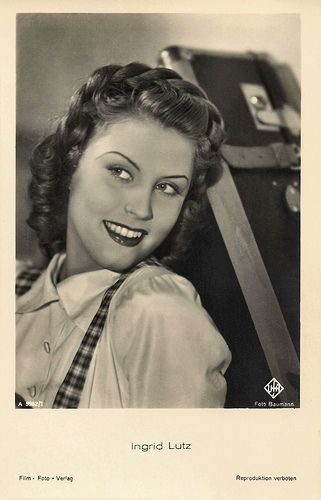
German postcard by Film-Foto-Verlag, no. A 3962/1, 1941-1944. Photo: Baumann / Ufa.
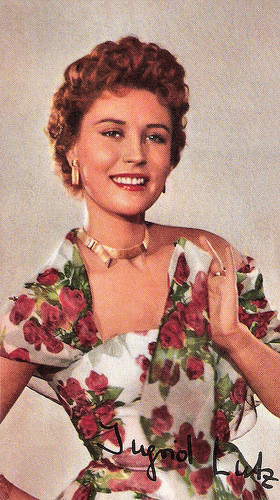
German collectors card by Lux.
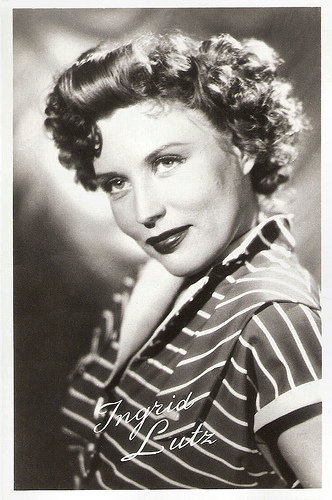
Dutch postcard by 't Sticht, Utrecht, no. 1434.
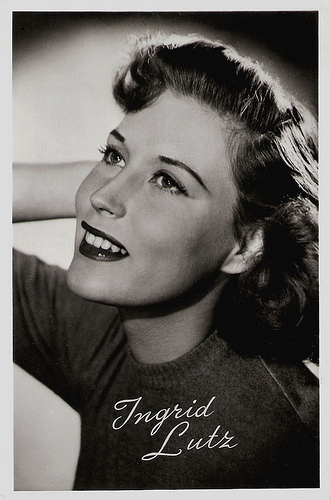
Dutch postcard, no. AX 1276.
A troubled production
Ingrid Marga Irene Lutz was born in 1924 in Berlin-Wilmersdorf.
She was the daughter of a dance teacher. Ingrid already danced in the children's ballet when she began her dance education at the Deutsche Oper, the German Opera House in Berlin. Later she took acting lessons.
At the age of 19, she got her first film roles. She played a little part in the comedy Ich vertraue Dir meine Frau/I Entrust My Wife to You (Kurt Hoffmann, 1943), starring Heinz Rühmann .
In 1944 she already played a leading role in the UFA production Junge Herzen/Young Hearts (Boleslaw Barlog, 1944) as student Lindy opposite Harald Holberg.
She also appeared in the comedy Sag' die Wahrheit/Tell the Truth (Helmut Weiss, 1946) starring Gustav Fröhlich , Mady Rahl , and Ingeborg von Kusserow. The film had a troubled production, and was originally filming in the final days of the Nazi era with Heinz Rühmann and his wife Hertha Feiler in the lead roles.
Production was halted when Soviet forces took control of the Tempelhof Studios during the Battle of Berlin. The film was then remade in the British sector of Berlin with different leads but using substantial amounts of footage already shot during the previous production.
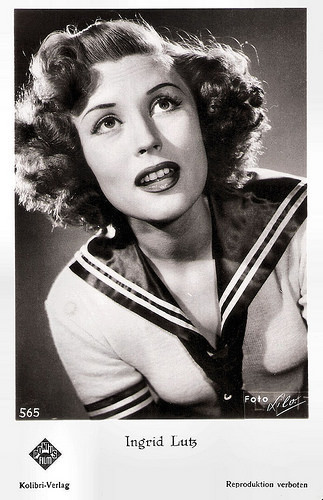
West-German postcard by Kolibri-Verlag, no. 565. Photo: Lilo / Pontus Film. Publicity still for Die verschleierte Maja/The Veiled Lady (Géza von Cziffra, 1951).
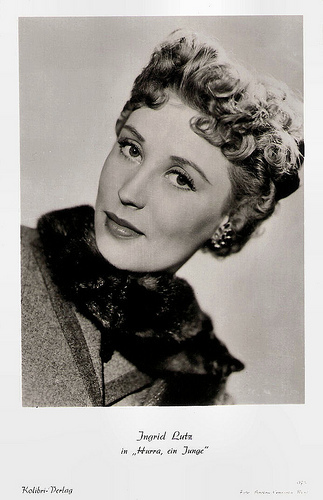
West-German postcard by Kolibri-Verlag, no. 675. Photo: Berolina / Constantin / Wesel. Publicity still for Hurra - ein Junge!/Hurrah, a Boy! (Ernst Marischka, Georg Jacoby, 1953).
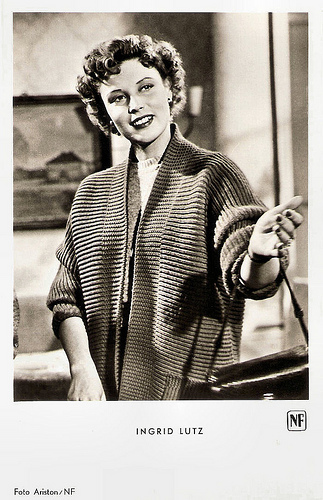
West-German postcard by Kunst und Bild, no. A 845. Photo: Ariston / NF. Publicity still for Die vertagte Hochzeitsnacht/The adjourned wedding night (Karl Georg Külb, 1953).
Science-Fiction film
After the war, Ingrid Lutz toured with the orchestra of Michael Jary, who also composed songs for her. Her most famous number was Das Ist Nichts für Kleine Mädchen (That's not for little girls), which she recited along with Rudolf Platte . She also sang songs together with Bully Buhlan.
In addition to her stage work, Lutz made a considerable number of films during the 1950s. She often was the spirited supporting actress in comedies, who could also dance and sing.
In Das kann jedem passieren/This can happen to anyone (Paul Verhoeven, 1952), she played showgirl Rita opposite Heinz Rühmann as a respectable husband in need of an explanation.
Other films were the romantic drama Bis wir uns wiedersehn/Until We Meet Again (Gustav Ucicky, 1952) starring Maria Schell and O.W. Fischer , the comedy Hurra - ein Junge!/Hooray, It's a Boy! (Ernst Marischka, Georg Jacoby, 1953) starring Walter Müller and Theo Lingen , and the comedy Ich und meine Schwiegersöhne/Me and My Sons-in-law (Georg Jacoby, 1956), starring Grethe Weiser .
Her final film was the Science-Fiction film Zurück aus dem Weltall/Moonwolf (Georges Friedland, 1959) with Carl Möhner .
Ingrid Lutz married three times. She first married society doctor Wolfgang Wohlgemuth. After her third marriage to a textile merchant, she retired to private life.
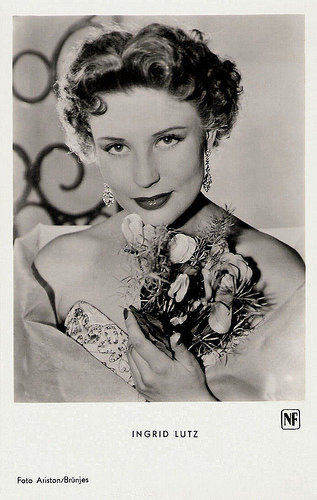
West-German postcard by Kunst und Bild, Berlin. Photo: Ariston / Brünjes / NF Film. Publicity still for Tante Jutta aus Kalkutta/Aunt Jutta from Calcutta (Karl Georg Külb, 1953).
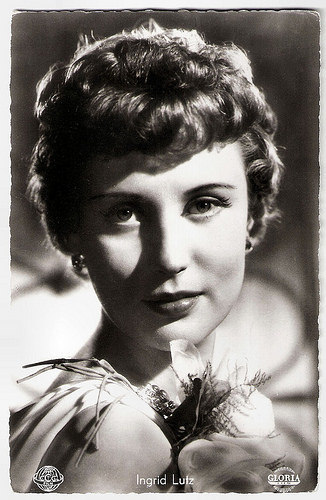
West-German postcard by Kolibri-Verlag, no. 1622. Photo: CCC / Gloria / Arthur Grimm. Publicity still for Du mein stilles Tal/You my quiet valley (Leonard Steckel, 1955).
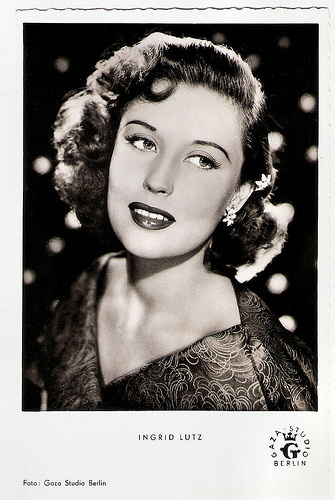
West-German postcard by Kunst und Bild, no. A 553. Photo: Gaza Studio, Berlin. Publicity still for Du mein stilles Tal/You my quiet valley (Leonard Steckel, 1955).
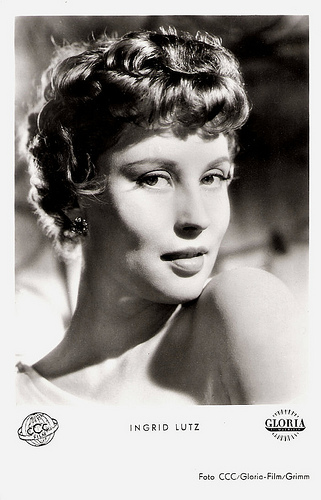
German postcard by Kunst und Bild, Berlin, no. T 629. Photo: CCC / Gloria-Film / Grimm. Publicity still for Du mein stilles Tal/You my quiet valley (Leonard Steckel, 1955).
Sources: Wikipedia (German and English) and .

German postcard by Film-Foto-Verlag, no. A 3962/1, 1941-1944. Photo: Baumann / Ufa.

German collectors card by Lux.

Dutch postcard by 't Sticht, Utrecht, no. 1434.

Dutch postcard, no. AX 1276.
A troubled production
Ingrid Marga Irene Lutz was born in 1924 in Berlin-Wilmersdorf.
She was the daughter of a dance teacher. Ingrid already danced in the children's ballet when she began her dance education at the Deutsche Oper, the German Opera House in Berlin. Later she took acting lessons.
At the age of 19, she got her first film roles. She played a little part in the comedy Ich vertraue Dir meine Frau/I Entrust My Wife to You (Kurt Hoffmann, 1943), starring Heinz Rühmann .
In 1944 she already played a leading role in the UFA production Junge Herzen/Young Hearts (Boleslaw Barlog, 1944) as student Lindy opposite Harald Holberg.
She also appeared in the comedy Sag' die Wahrheit/Tell the Truth (Helmut Weiss, 1946) starring Gustav Fröhlich , Mady Rahl , and Ingeborg von Kusserow. The film had a troubled production, and was originally filming in the final days of the Nazi era with Heinz Rühmann and his wife Hertha Feiler in the lead roles.
Production was halted when Soviet forces took control of the Tempelhof Studios during the Battle of Berlin. The film was then remade in the British sector of Berlin with different leads but using substantial amounts of footage already shot during the previous production.

West-German postcard by Kolibri-Verlag, no. 565. Photo: Lilo / Pontus Film. Publicity still for Die verschleierte Maja/The Veiled Lady (Géza von Cziffra, 1951).

West-German postcard by Kolibri-Verlag, no. 675. Photo: Berolina / Constantin / Wesel. Publicity still for Hurra - ein Junge!/Hurrah, a Boy! (Ernst Marischka, Georg Jacoby, 1953).

West-German postcard by Kunst und Bild, no. A 845. Photo: Ariston / NF. Publicity still for Die vertagte Hochzeitsnacht/The adjourned wedding night (Karl Georg Külb, 1953).
Science-Fiction film
After the war, Ingrid Lutz toured with the orchestra of Michael Jary, who also composed songs for her. Her most famous number was Das Ist Nichts für Kleine Mädchen (That's not for little girls), which she recited along with Rudolf Platte . She also sang songs together with Bully Buhlan.
In addition to her stage work, Lutz made a considerable number of films during the 1950s. She often was the spirited supporting actress in comedies, who could also dance and sing.
In Das kann jedem passieren/This can happen to anyone (Paul Verhoeven, 1952), she played showgirl Rita opposite Heinz Rühmann as a respectable husband in need of an explanation.
Other films were the romantic drama Bis wir uns wiedersehn/Until We Meet Again (Gustav Ucicky, 1952) starring Maria Schell and O.W. Fischer , the comedy Hurra - ein Junge!/Hooray, It's a Boy! (Ernst Marischka, Georg Jacoby, 1953) starring Walter Müller and Theo Lingen , and the comedy Ich und meine Schwiegersöhne/Me and My Sons-in-law (Georg Jacoby, 1956), starring Grethe Weiser .
Her final film was the Science-Fiction film Zurück aus dem Weltall/Moonwolf (Georges Friedland, 1959) with Carl Möhner .
Ingrid Lutz married three times. She first married society doctor Wolfgang Wohlgemuth. After her third marriage to a textile merchant, she retired to private life.

West-German postcard by Kunst und Bild, Berlin. Photo: Ariston / Brünjes / NF Film. Publicity still for Tante Jutta aus Kalkutta/Aunt Jutta from Calcutta (Karl Georg Külb, 1953).

West-German postcard by Kolibri-Verlag, no. 1622. Photo: CCC / Gloria / Arthur Grimm. Publicity still for Du mein stilles Tal/You my quiet valley (Leonard Steckel, 1955).

West-German postcard by Kunst und Bild, no. A 553. Photo: Gaza Studio, Berlin. Publicity still for Du mein stilles Tal/You my quiet valley (Leonard Steckel, 1955).

German postcard by Kunst und Bild, Berlin, no. T 629. Photo: CCC / Gloria-Film / Grimm. Publicity still for Du mein stilles Tal/You my quiet valley (Leonard Steckel, 1955).
Sources: Wikipedia (German and English) and .
Published on July 16, 2018 23:00
July 15, 2018
Enrique Rivero
Enrique Rivero (1906-1954) was a Chilean actor, who peaked in late 1920s and early 1930s French cinema. He was for a time seen as the Valentino of the European cinema and became famous for his lead in Jean Cocteau's Le sang d'un poète/The Blood of a Poet (1930).
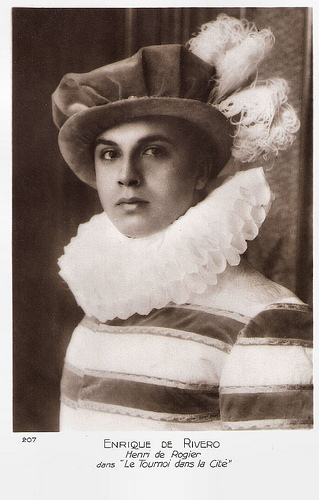
French postcard by Cinémagazine-Edition, no. 207. Photo: publicity still for Le tournoi dans la cité/The Tournament (Jean Renoir, 1928), with Enrique (de) Rivero as Henri de Rogier. The film was scripted by Henry Dupuis-Mazuel. Sets by Robert Mallet-Stevens, costumes by George Barbier and exteriors shot at Carcassonne.
The new Rudolph Valentino
Enrique Rivero was born Enrique Riveros in San Fernando, Chile, in 1906. He was the eldest son of prominent businessman Enrique Riveros and Mrs. Hortensia Fernández Prado.
He travelled to Paris in 1922 to study agronomy, but against his family's wishes he soon became part of the art world and the historical avant-garde film that dominated the European scene and Paris. He mingled with a.o. Pablo Picasso, Man Ray, Gertrude Stein, Coco Chanel, Luis Buñuel, Lee Miller and the Viscount de Noailles.
From 1925, Riveros worked as supporting actor or as lead in over 15 films, credited as Enrique de Rivero or Enrique Rivero. His first films were Mon curé chez les pauvres/My Priest among the Poor (Donatien, 1925), Mon frère Jacques/My brother Jacques (Marcel Manchez, 1926) starring Dolly Davis , and Le chemineau/The trench (Maurice Kéroul, Georges Monca, 1926) starring Henri Baudin .
He appeared in two Swedish films Ungdom/Youth (Ragnar Hyltén-Cavallius, 1927) starring Ivan Hedqvist, and Spökbaronen/Ghost Baron (Gustaf Edgren, 1927) starring Fridolf Rhudin, and in the German-Swedish production Majestät schneidet Bubiköpfe/Majesty cuts bobble heads (Ragnar Hyltén-Cavallius, 1928) opposite Hans Junkermann.
Jean Renoir directed him in two late silent films, the costume drama Le tournoi dans la cite/The Tournament (1928) and the adventure film Le bled/The Bled (1929), in which he co-starred with Jackie Monnier. In the late 1920s and early 1930s, Rivero's fame and success were so bright, that he continuously appeared on European film magazine covers, considered as the new Rudolph Valentino .
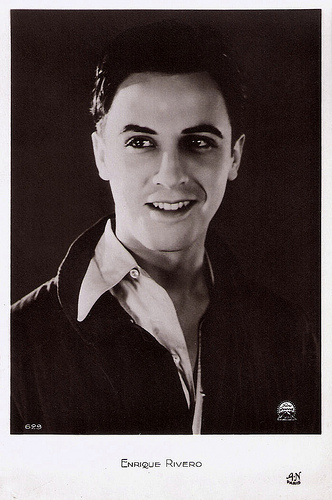
French postcard by A.N., Paris, no. 629. Photo: Paramount.
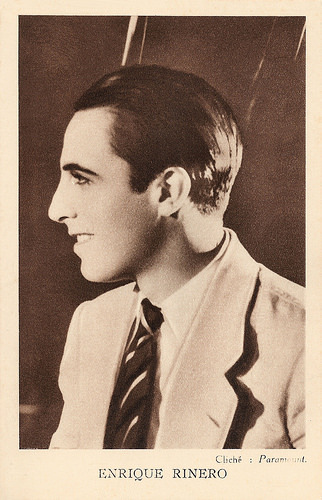
Belgian postcard by Kivou, Vilvoorde. Photo: Paramount.
Attempts on his life and jealousy affairs
In 1930, Enrique Rivero appeared as the protagonist of Le sang d'un poète/The Blood of a Poet (1930), the first film by French artist Jean Cocteau, and considered one of the highlights of surrealist cinema. Because of its presumed blasphemous content and because of the riot over L'Age d'or by Luis Buñuel and Salvador Dali, the film was only released in 1932.
Todd Kristel at AllMovie : "Inspired by the myth of Orpheus and details from Jean Cocteau's own life, The Blood of a Poet is a fascinating, but somewhat confusing look at the struggle to create art. (...) the movie is unusual because Cocteau wanted to express his ideas in a creative way and not simply because he wanted to confuse people."
In the first part of the film an artist (Rivero) sketches a face of which the mouth starts moving; rubbing the mouth it sticks to his hand, and later on to an armless female statue (Lee Miller). Incited by the statue come to life, he passes a mirror and enters a magic world, looking through various keyholes. In the end he returns, smashes the statue, his ambiguous muse, and becomes a statue himself.
Rivero also acted in two early sound films by Alberto Cavalcanti in the Paramount studios in Joinville. The first was Dans une île perdue/On a lost Island (1931) with Danièle Parola, an alternative language version of Dangerous Paradise (William Wellman, 1930) with Nancy Carroll and Richard Arlen. The other was À mi-chemin du ciel/Halfway Up the Sky (1931) with Janine Merrey, an alternative language version of Half Way to Heaven (George Abbott, 1929) with Chrales 'Buddy' Rogers.
Among his other films were the Spanish-French coproduction La bodega/Wine Cellars (Benito Perojo, 1930), with the actress and singer Concha Piquer, Nicole et sa vertu/Nicole and her Virtue (Rene Hervil, 1932), starring Alice Cocéa, and the drama Le picador/The Picador (Lucien Jaquelux, 1932).
Shortly before the outbreak of World War II, Enrique Riveros returned to Chile for unknown reasons, leaving behind fame, fortune, and a wife and daughter. Swedish Wikipedia suggests he was involved in attempts on his life because of private jealousy affairs.
In Chile, Enrique Riveros led a quiet life, worked on a couple of film projects and starred under his birthname in the thriller El hombre que se llevaron/The man who took (Jorge 'Coke' Delano, 1946). For his role of defendant Alberto, Rivero received the award for Best National Film Actor.
Enrique Riveros died in 1954, all too soon - and all too soon forgotten.
Three gifs from Le sang d'un poète/The Blood of a Poet (1930). Source: GIPHY.
Sources: AllMovie, Wikipedia (English and Swedish), and .

French postcard by Cinémagazine-Edition, no. 207. Photo: publicity still for Le tournoi dans la cité/The Tournament (Jean Renoir, 1928), with Enrique (de) Rivero as Henri de Rogier. The film was scripted by Henry Dupuis-Mazuel. Sets by Robert Mallet-Stevens, costumes by George Barbier and exteriors shot at Carcassonne.
The new Rudolph Valentino
Enrique Rivero was born Enrique Riveros in San Fernando, Chile, in 1906. He was the eldest son of prominent businessman Enrique Riveros and Mrs. Hortensia Fernández Prado.
He travelled to Paris in 1922 to study agronomy, but against his family's wishes he soon became part of the art world and the historical avant-garde film that dominated the European scene and Paris. He mingled with a.o. Pablo Picasso, Man Ray, Gertrude Stein, Coco Chanel, Luis Buñuel, Lee Miller and the Viscount de Noailles.
From 1925, Riveros worked as supporting actor or as lead in over 15 films, credited as Enrique de Rivero or Enrique Rivero. His first films were Mon curé chez les pauvres/My Priest among the Poor (Donatien, 1925), Mon frère Jacques/My brother Jacques (Marcel Manchez, 1926) starring Dolly Davis , and Le chemineau/The trench (Maurice Kéroul, Georges Monca, 1926) starring Henri Baudin .
He appeared in two Swedish films Ungdom/Youth (Ragnar Hyltén-Cavallius, 1927) starring Ivan Hedqvist, and Spökbaronen/Ghost Baron (Gustaf Edgren, 1927) starring Fridolf Rhudin, and in the German-Swedish production Majestät schneidet Bubiköpfe/Majesty cuts bobble heads (Ragnar Hyltén-Cavallius, 1928) opposite Hans Junkermann.
Jean Renoir directed him in two late silent films, the costume drama Le tournoi dans la cite/The Tournament (1928) and the adventure film Le bled/The Bled (1929), in which he co-starred with Jackie Monnier. In the late 1920s and early 1930s, Rivero's fame and success were so bright, that he continuously appeared on European film magazine covers, considered as the new Rudolph Valentino .

French postcard by A.N., Paris, no. 629. Photo: Paramount.

Belgian postcard by Kivou, Vilvoorde. Photo: Paramount.
Attempts on his life and jealousy affairs
In 1930, Enrique Rivero appeared as the protagonist of Le sang d'un poète/The Blood of a Poet (1930), the first film by French artist Jean Cocteau, and considered one of the highlights of surrealist cinema. Because of its presumed blasphemous content and because of the riot over L'Age d'or by Luis Buñuel and Salvador Dali, the film was only released in 1932.
Todd Kristel at AllMovie : "Inspired by the myth of Orpheus and details from Jean Cocteau's own life, The Blood of a Poet is a fascinating, but somewhat confusing look at the struggle to create art. (...) the movie is unusual because Cocteau wanted to express his ideas in a creative way and not simply because he wanted to confuse people."
In the first part of the film an artist (Rivero) sketches a face of which the mouth starts moving; rubbing the mouth it sticks to his hand, and later on to an armless female statue (Lee Miller). Incited by the statue come to life, he passes a mirror and enters a magic world, looking through various keyholes. In the end he returns, smashes the statue, his ambiguous muse, and becomes a statue himself.
Rivero also acted in two early sound films by Alberto Cavalcanti in the Paramount studios in Joinville. The first was Dans une île perdue/On a lost Island (1931) with Danièle Parola, an alternative language version of Dangerous Paradise (William Wellman, 1930) with Nancy Carroll and Richard Arlen. The other was À mi-chemin du ciel/Halfway Up the Sky (1931) with Janine Merrey, an alternative language version of Half Way to Heaven (George Abbott, 1929) with Chrales 'Buddy' Rogers.
Among his other films were the Spanish-French coproduction La bodega/Wine Cellars (Benito Perojo, 1930), with the actress and singer Concha Piquer, Nicole et sa vertu/Nicole and her Virtue (Rene Hervil, 1932), starring Alice Cocéa, and the drama Le picador/The Picador (Lucien Jaquelux, 1932).
Shortly before the outbreak of World War II, Enrique Riveros returned to Chile for unknown reasons, leaving behind fame, fortune, and a wife and daughter. Swedish Wikipedia suggests he was involved in attempts on his life because of private jealousy affairs.
In Chile, Enrique Riveros led a quiet life, worked on a couple of film projects and starred under his birthname in the thriller El hombre que se llevaron/The man who took (Jorge 'Coke' Delano, 1946). For his role of defendant Alberto, Rivero received the award for Best National Film Actor.
Enrique Riveros died in 1954, all too soon - and all too soon forgotten.
Three gifs from Le sang d'un poète/The Blood of a Poet (1930). Source: GIPHY.
Sources: AllMovie, Wikipedia (English and Swedish), and .
Published on July 15, 2018 22:00
July 14, 2018
New GDI acquisition: British cigarette cards
Egbert Barten of the Geoffrey Donaldson Institute lent me some cigarette cards he recently acquired, to share with you. Earlier we did some posts on cigarette cards by Ross Verlag in Berlin, but these very small cards (ca. 6.5 x 3.5 cm or 2.6 x 1.2 inches) were all produced in the 1930s by various tobacco firms in Great Britain to be included in cigarette packs.
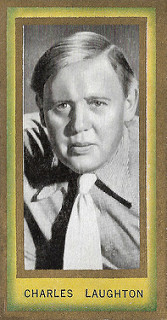
Charles Laughton . British cigarette card in the Film Favourites series by Carreras LTD, Arcadia Works, London, no. 28. Photo: Mayflower Pictures. Collection: Geoffrey Donaldson Institute.
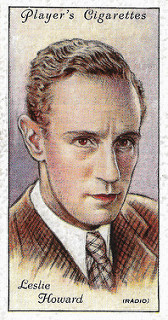
Leslie Howard . British cigarette card in the Second Film Stars series by John Player & Sons, no. 26. Photo: Radio. Collection: Geoffrey Donaldson Institute.
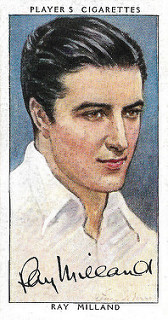
Ray Milland . British cigarette card in the Third Film Stars series by John Player & Sons, no. 30. Photo: Paramount. Collection: Geoffrey Donaldson Institute.
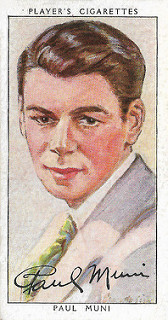
Paul Muni. British cigarette card in the Third Film Stars series by John Player & Sons, no. 32. Photo: Warner - First National. Collection: Geoffrey Donaldson Institute.
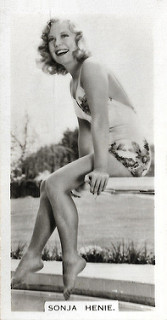
Sonja Henie . British cigarette card in the Film & Stage Beauties series by Carreras LTD, Arcadia Works, London, no. 16. Photo: 20th Century Fox. Collection: Geoffrey Donaldson Institute.
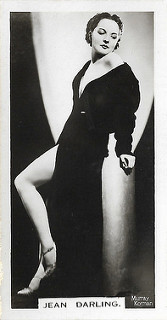
Jean Darling. British cigarette card in the Film & Stage Beauties series by Carreras LTD, Arcadia Works, London, no. 34. Photo: Murray Korman. Collection: Geoffrey Donaldson Institute.
Our Gang Darling
Jean Darling (1922-2015) was an American child actress who was a regular in the Our Gang short subjects series from 1927-1929. As an adult, she performed on Broadway. The Film & Stage Beauties series above was a series of 54 real photographs issued with Carreras cigarettes. A Carreras slip-in album was obtainable from all tobacconists. The price was One Penny, and the albums for the other series had the same price. The Stars of Screen & Stage series below consisted of 48 cards.
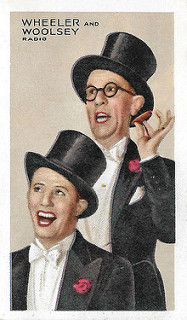
Wheeler & Woolsey. British cigarette card in the Stars of Screen & Stage series by Park Drive Cigarettes, Gallaher Ltd., London & Belfast, no. 6. Photo: Radio. Collection: Geoffrey Donaldson Institute.
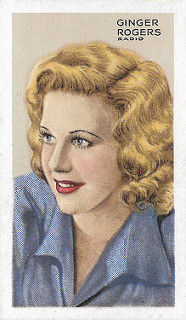
Ginger Rogers. British cigarette card in the Stars of Screen & Stage series by Park Drive Cigarettes, Gallaher Ltd., London & Belfast, no. 14. Photo: Radio. Collection: Geoffrey Donaldson Institute.
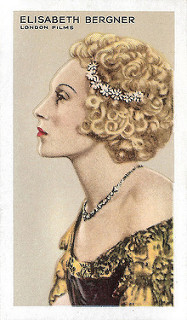
Elisabeth Bergner . British cigarette card in the Stars of Screen & Stage series by Park Drive Cigarettes, Gallaher Ltd., London & Belfast, no. 17. Photo: London Films. Publicity still for The Rise of Catherine the Great (Paul Czinner, 1934). Collection: Geoffrey Donaldson Institute.
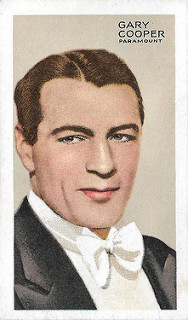
Gary Cooper. British cigarette card in the Stars of Screen & Stage series by Park Drive Cigarettes, Gallaher Ltd., London & Belfast, no. 24. Photo: Paramount. Collection: Geoffrey Donaldson Institute.
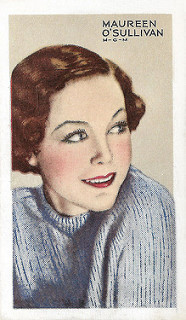
Maureen O'Sullivan. British cigarette card in the Stars of Screen & Stage series by Park Drive Cigarettes, Gallaher Ltd., London & Belfast, no. 25. Photo: M.G.M. Collection: Geoffrey Donaldson Institute.
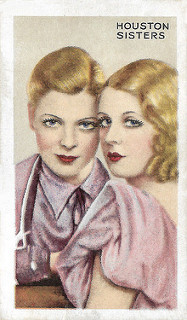
The Houston Sisters. British cigarette card in the Stars of Screen & Stage series by Park Drive Cigarettes, Gallaher Ltd., London & Belfast, no. 43. Photo: M.G.M. Collection: Geoffrey Donaldson Institute.
Sibling Rivalry
Scottish sisters Renee Houston (1902-1980) and Billie Houston (1906-1972) were the daughters of a liquor salesman, James Gribbon, who, with his wife, Elizabeth Houston, later formed a variety song-and-dance act. The sisters formed their own music hall double act as the 'Houston Sisters', also known as 'The Irresistibles'. Their comedy was based on sibling rivalry and Scottish working-class life and in 1926 they appeared before the Kind and Queen at the Royal Command Performance. After World War II, Renee appeared in middle-aged roles in many British films as tough mothers and assorted harridans. She also appeared as comic support in several instalments of the Carry On series.
Sources: and cigarette cards.

Charles Laughton . British cigarette card in the Film Favourites series by Carreras LTD, Arcadia Works, London, no. 28. Photo: Mayflower Pictures. Collection: Geoffrey Donaldson Institute.

Leslie Howard . British cigarette card in the Second Film Stars series by John Player & Sons, no. 26. Photo: Radio. Collection: Geoffrey Donaldson Institute.

Ray Milland . British cigarette card in the Third Film Stars series by John Player & Sons, no. 30. Photo: Paramount. Collection: Geoffrey Donaldson Institute.

Paul Muni. British cigarette card in the Third Film Stars series by John Player & Sons, no. 32. Photo: Warner - First National. Collection: Geoffrey Donaldson Institute.

Sonja Henie . British cigarette card in the Film & Stage Beauties series by Carreras LTD, Arcadia Works, London, no. 16. Photo: 20th Century Fox. Collection: Geoffrey Donaldson Institute.

Jean Darling. British cigarette card in the Film & Stage Beauties series by Carreras LTD, Arcadia Works, London, no. 34. Photo: Murray Korman. Collection: Geoffrey Donaldson Institute.
Our Gang Darling
Jean Darling (1922-2015) was an American child actress who was a regular in the Our Gang short subjects series from 1927-1929. As an adult, she performed on Broadway. The Film & Stage Beauties series above was a series of 54 real photographs issued with Carreras cigarettes. A Carreras slip-in album was obtainable from all tobacconists. The price was One Penny, and the albums for the other series had the same price. The Stars of Screen & Stage series below consisted of 48 cards.

Wheeler & Woolsey. British cigarette card in the Stars of Screen & Stage series by Park Drive Cigarettes, Gallaher Ltd., London & Belfast, no. 6. Photo: Radio. Collection: Geoffrey Donaldson Institute.

Ginger Rogers. British cigarette card in the Stars of Screen & Stage series by Park Drive Cigarettes, Gallaher Ltd., London & Belfast, no. 14. Photo: Radio. Collection: Geoffrey Donaldson Institute.

Elisabeth Bergner . British cigarette card in the Stars of Screen & Stage series by Park Drive Cigarettes, Gallaher Ltd., London & Belfast, no. 17. Photo: London Films. Publicity still for The Rise of Catherine the Great (Paul Czinner, 1934). Collection: Geoffrey Donaldson Institute.

Gary Cooper. British cigarette card in the Stars of Screen & Stage series by Park Drive Cigarettes, Gallaher Ltd., London & Belfast, no. 24. Photo: Paramount. Collection: Geoffrey Donaldson Institute.

Maureen O'Sullivan. British cigarette card in the Stars of Screen & Stage series by Park Drive Cigarettes, Gallaher Ltd., London & Belfast, no. 25. Photo: M.G.M. Collection: Geoffrey Donaldson Institute.

The Houston Sisters. British cigarette card in the Stars of Screen & Stage series by Park Drive Cigarettes, Gallaher Ltd., London & Belfast, no. 43. Photo: M.G.M. Collection: Geoffrey Donaldson Institute.
Sibling Rivalry
Scottish sisters Renee Houston (1902-1980) and Billie Houston (1906-1972) were the daughters of a liquor salesman, James Gribbon, who, with his wife, Elizabeth Houston, later formed a variety song-and-dance act. The sisters formed their own music hall double act as the 'Houston Sisters', also known as 'The Irresistibles'. Their comedy was based on sibling rivalry and Scottish working-class life and in 1926 they appeared before the Kind and Queen at the Royal Command Performance. After World War II, Renee appeared in middle-aged roles in many British films as tough mothers and assorted harridans. She also appeared as comic support in several instalments of the Carry On series.
Sources: and cigarette cards.
Published on July 14, 2018 22:00
July 13, 2018
Photo by Studio Harcourt
From 1934 on, Studio Harcourt in Paris immortalised some of the greatest figures of the 20th century. The French dream factory produced 1,500 iconic black and-white photographs of film stars as Gérard Philippe, Simone Signoret and Michèle Morgan, and singers as Edith Piaf, Charles Trenet and Juliette Gréco.

Juliette Gréco . French postcard by Editions du Globe (EDUG), no. 191. Photo: Studio Harcourt, Paris.

Daniel Gelin . French postcard by Editions du Globe, Paris, no. 156. Photo: Studio Harcourt.
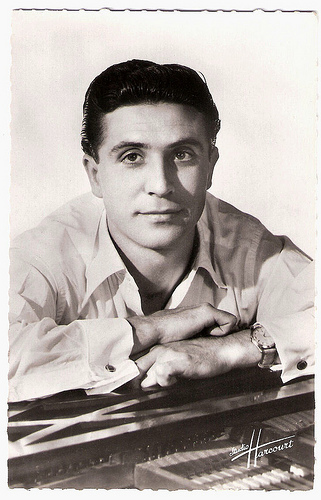
Gilbert Bécaud . French postcard by Editions du Globe (EDUG), no. 250. Photo: Studio Harcourt.
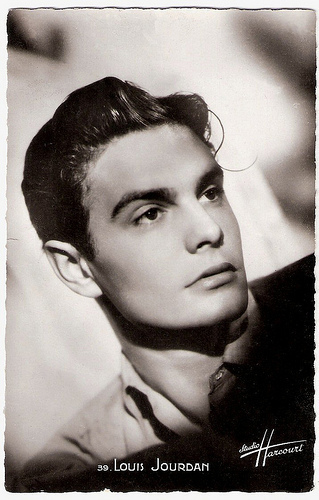
Louis Jourdan . French postcard by S.E.R.P., Paris, no. 39. Photo: Studio Harcourt.
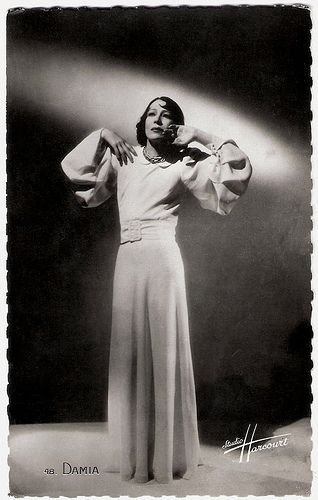
Damia . French postcard by S.E.R.P., no. 48. Photo: Studio Harcourt.
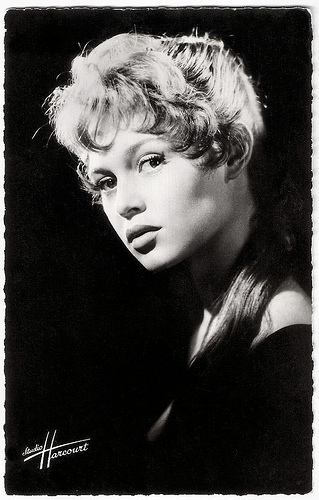
Brigitte Bardot . French postcard by Editions du Globe, Paris, no. 338. Photo: Studio Harcourt.
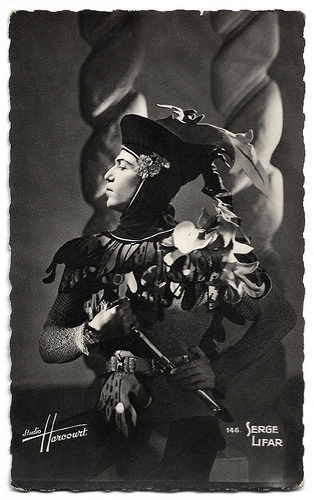
Serge Lifar. French postcard, no. 146. Photo: Studio Harcourt.
Hello!
Cosette Harcourt founded Studio Harcourt in 1934, at a time when prestigious photo studios like Nadar closed for lack of clients. The new studio, located in a mansion on avenue Iéna, in the 16th arrondissement, was financed by the French publishers Jacques and Jean Lacroix, and Robert Ricci, son of Nina Ricci.
Cosette Harcourt a.k.a. Germaine Hirschefeld (1900–1976) was a photographer who had worked in the studio of the brothers Manuel . The original concept was to photograph for Lacroix’s publications Hello! for the French intelligentsia.
The change in direction came when Cosette Harcourt started to specialise in black-and-white glamour photography of figures from French cinema and culture. Harcourt photographed celebrities like Marlene Dietrich , Edith Piaf , Maurice Chevalier , Josephine Baker , and Coco Chanel.
She always used 24 x 30 cm prints immediately recognisable for their distinctive style and lighting. This typical Harcourt style consists in a photo taken at close distance to the subject in its best light, generally creating a halo of light and dark, on a gray-to-black background.
At his blog, Belgian photographer-teacher Herman Huys writes that the studio uses only Tungsten lighting: “Each part of the body or the face is illuminated separately by a light with a power of 500watt. Each light have also barn doors, so the photographer can manipulate the beam of light, a small part is lighted.”
Reflectors lower the contrast in the shadows. The attitude of the subject is personal, often wearing a slight smile, but somehow the Harcourt photos always feel a little staged. The Harcourt logo is featured prominently in the lower right-hand (sometimes left-hand) corner on every print and postcard.
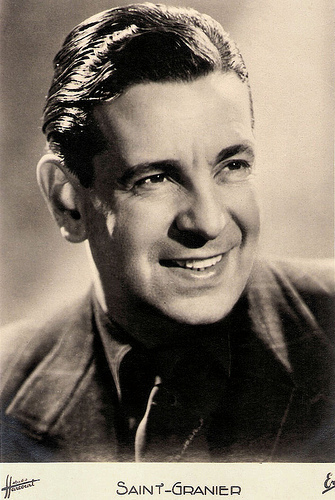
Saint-Granier . French postcard by Erpé. Photo: Studio Harcourt.
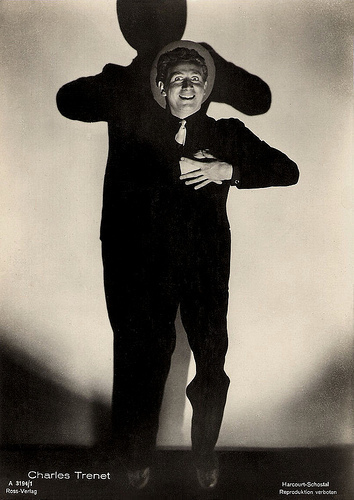
Charles Trenet . German postcard by Ross-Verlag, no. A 3194, 1941-1944. Photo: Harcourt-Schostal.
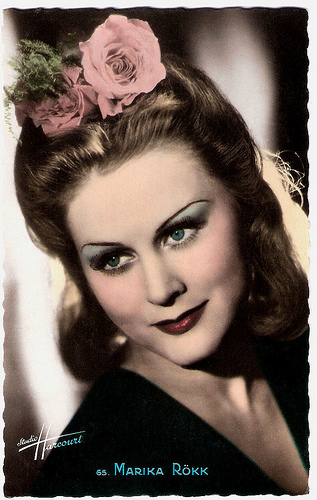
Marika Rökk . French postcard by S.E.R.P., Paris, no. 65. Photo: Studio Harcourt.
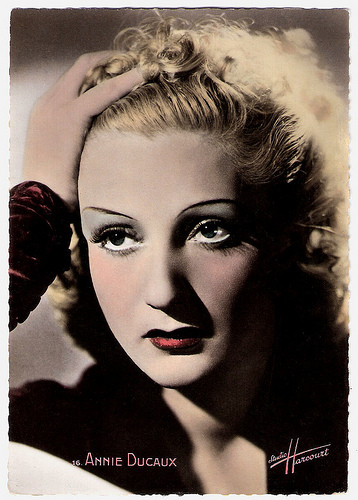
Annie Ducaux . French postcard by GREFF, S.E.R.P., Paris, no. 16. Photo: Studio Harcourt.
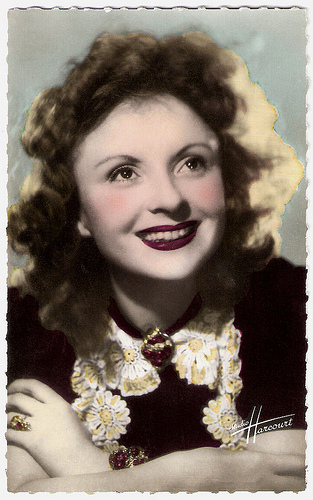
Odette Joyeux . French postcard by Editions O.P., Paris, no. 46. Photo: Studio Harcourt.
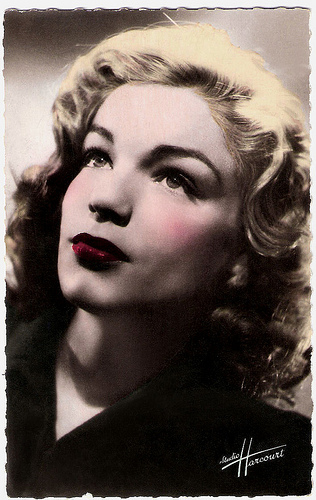
Simone Signoret . French postcard by Editions O.P., no. 19. Photo: Studio Harcourt.
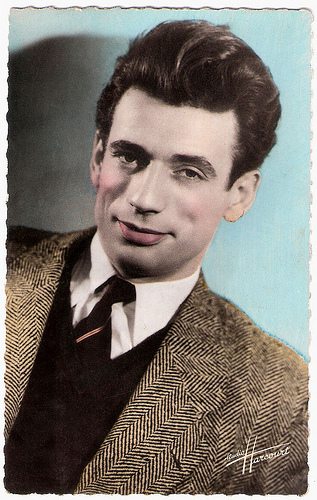
Yves Montand . French postcard by Editions O.P., Paris, no. 11. Photo: Studio Harcourt.
German and American Officers
The Harcourt style was inspired by the lighting effects which cinematographer Henri Alekan used in black & white films of Jean Cocteau and other great French directors of the 1930s and 1940s.
Around the time of World War II, Cosette Harcourt who was Jewish, married one of the Lacroix brothers. Together they created a magazine, called Stars, to serve as an outlet for studio photos.
During the occupation the German officers and many members of the regime of Vichy visited the studios, just as the Americans did after the French Liberation.
After the war, Harcourt regained its momentum with the photography of stars like Jean Gabin , Gérard Philipe , Anouk Aimée , Brigitte Bardot and Alain Delon . The studio continued the tradition that made it successful initially and having your photo taken at Harcourt a few times during your life became standard for the French elite.
In the 1960s with the rise of the Nouvelle Vague and the dawn of a realist, anti glamorous aesthetic the studio’s peak was over. Clients demanded to be photographed at home, on location, away from anywhere that resembled a conventional studio. With the innovation of the flash, the magic and mystery of the studio disappeared. And nobody wanted black and white portraits anymore.
After the death of Cosette Harcourt in 1976, the ownership of the studio changed several times. In 2000, under the leadership of Jack Lang, the French state bought the photos of Studio Harcourt from between 1934 to 1991: about 5 million negatives of 550,000 persons and 1,500 celebrities. The collection is distributed by the Réunion des Musées Nationaux (RMN).
In 2007, Studio Harcourt was bought by Francis Dagnan with Catherine Renard at the helm. Its tradition has been reinstated: there are no star photographers and all employees work for Studio Harcourt. The studio is now located at 6, rue de Lota near the Porte Dauphine. Having your photo taken at Harcourt in a 2 hour session costs from 1,995 Euros.
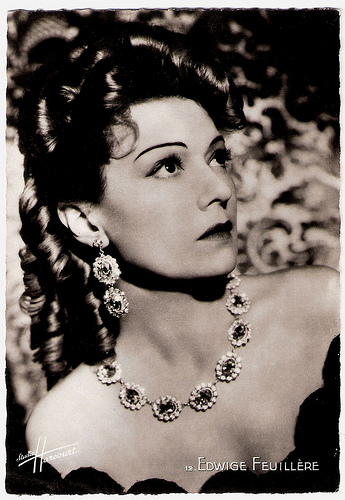
Edwige Feuillère. French postcard by S.E.R.P., Paris, no. 12. Photo: Studio Harcourt.
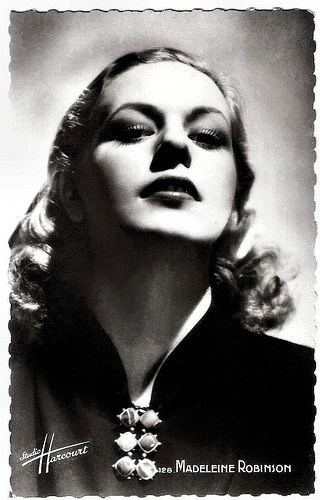
Madeleine Robinson . French postcard by SERP, no. 128. Photo: Studio Harcourt.
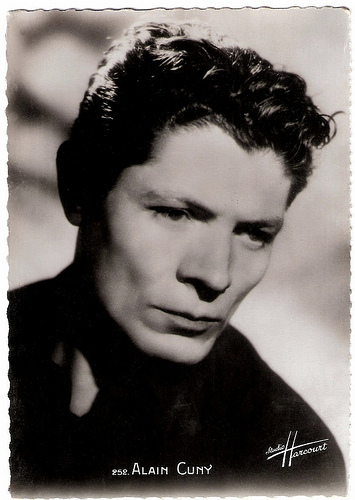
Alain Cuny . French postcard by S.E.R.P., Paris, no. 252. Photo: Studio Harcourt.
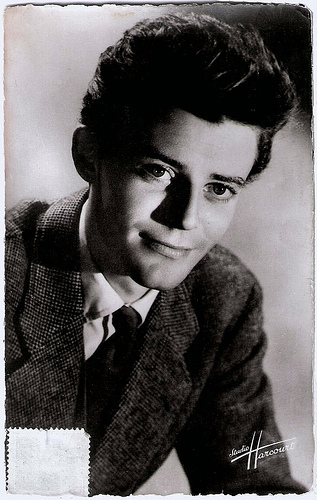
Gérard Philipe . French postcard by Editions du Globe (E.D.U.G.), Paris, no. 31. Photo: Studio Harcourt.
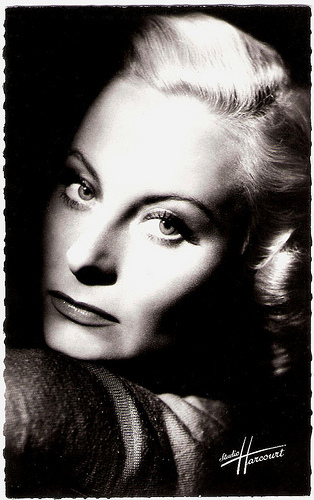
Michèle Morgan . French postcard by Editions du Globe (E.D.U.G.), no. 66. Photo: Studio Harcourt.
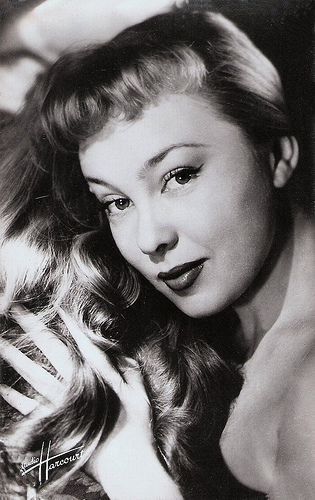
Dominique Wilms . French postcard by Editions du Globe (E.D.U.G.), no. 233. Photo: Studio Harcourt.
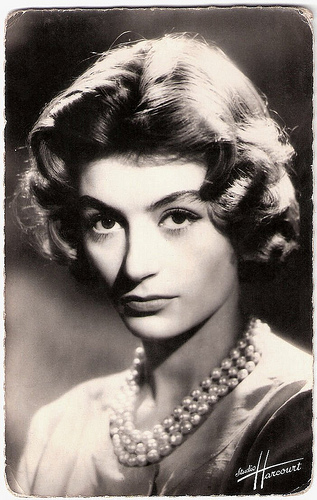
Anouk Aimée . French postcard by Editions du Globe (E.D.U.G.), Paris, no. 702. Photo: Studio Harcourt.
Sources: Margaret Kemp (Bonjour Paris), Sascha Lehnartz (Welt online - German), Herman Huys, Studio-Harcourt.eu, and Wikipedia.

Juliette Gréco . French postcard by Editions du Globe (EDUG), no. 191. Photo: Studio Harcourt, Paris.

Daniel Gelin . French postcard by Editions du Globe, Paris, no. 156. Photo: Studio Harcourt.

Gilbert Bécaud . French postcard by Editions du Globe (EDUG), no. 250. Photo: Studio Harcourt.

Louis Jourdan . French postcard by S.E.R.P., Paris, no. 39. Photo: Studio Harcourt.

Damia . French postcard by S.E.R.P., no. 48. Photo: Studio Harcourt.

Brigitte Bardot . French postcard by Editions du Globe, Paris, no. 338. Photo: Studio Harcourt.

Serge Lifar. French postcard, no. 146. Photo: Studio Harcourt.
Hello!
Cosette Harcourt founded Studio Harcourt in 1934, at a time when prestigious photo studios like Nadar closed for lack of clients. The new studio, located in a mansion on avenue Iéna, in the 16th arrondissement, was financed by the French publishers Jacques and Jean Lacroix, and Robert Ricci, son of Nina Ricci.
Cosette Harcourt a.k.a. Germaine Hirschefeld (1900–1976) was a photographer who had worked in the studio of the brothers Manuel . The original concept was to photograph for Lacroix’s publications Hello! for the French intelligentsia.
The change in direction came when Cosette Harcourt started to specialise in black-and-white glamour photography of figures from French cinema and culture. Harcourt photographed celebrities like Marlene Dietrich , Edith Piaf , Maurice Chevalier , Josephine Baker , and Coco Chanel.
She always used 24 x 30 cm prints immediately recognisable for their distinctive style and lighting. This typical Harcourt style consists in a photo taken at close distance to the subject in its best light, generally creating a halo of light and dark, on a gray-to-black background.
At his blog, Belgian photographer-teacher Herman Huys writes that the studio uses only Tungsten lighting: “Each part of the body or the face is illuminated separately by a light with a power of 500watt. Each light have also barn doors, so the photographer can manipulate the beam of light, a small part is lighted.”
Reflectors lower the contrast in the shadows. The attitude of the subject is personal, often wearing a slight smile, but somehow the Harcourt photos always feel a little staged. The Harcourt logo is featured prominently in the lower right-hand (sometimes left-hand) corner on every print and postcard.

Saint-Granier . French postcard by Erpé. Photo: Studio Harcourt.

Charles Trenet . German postcard by Ross-Verlag, no. A 3194, 1941-1944. Photo: Harcourt-Schostal.

Marika Rökk . French postcard by S.E.R.P., Paris, no. 65. Photo: Studio Harcourt.

Annie Ducaux . French postcard by GREFF, S.E.R.P., Paris, no. 16. Photo: Studio Harcourt.

Odette Joyeux . French postcard by Editions O.P., Paris, no. 46. Photo: Studio Harcourt.

Simone Signoret . French postcard by Editions O.P., no. 19. Photo: Studio Harcourt.

Yves Montand . French postcard by Editions O.P., Paris, no. 11. Photo: Studio Harcourt.
German and American Officers
The Harcourt style was inspired by the lighting effects which cinematographer Henri Alekan used in black & white films of Jean Cocteau and other great French directors of the 1930s and 1940s.
Around the time of World War II, Cosette Harcourt who was Jewish, married one of the Lacroix brothers. Together they created a magazine, called Stars, to serve as an outlet for studio photos.
During the occupation the German officers and many members of the regime of Vichy visited the studios, just as the Americans did after the French Liberation.
After the war, Harcourt regained its momentum with the photography of stars like Jean Gabin , Gérard Philipe , Anouk Aimée , Brigitte Bardot and Alain Delon . The studio continued the tradition that made it successful initially and having your photo taken at Harcourt a few times during your life became standard for the French elite.
In the 1960s with the rise of the Nouvelle Vague and the dawn of a realist, anti glamorous aesthetic the studio’s peak was over. Clients demanded to be photographed at home, on location, away from anywhere that resembled a conventional studio. With the innovation of the flash, the magic and mystery of the studio disappeared. And nobody wanted black and white portraits anymore.
After the death of Cosette Harcourt in 1976, the ownership of the studio changed several times. In 2000, under the leadership of Jack Lang, the French state bought the photos of Studio Harcourt from between 1934 to 1991: about 5 million negatives of 550,000 persons and 1,500 celebrities. The collection is distributed by the Réunion des Musées Nationaux (RMN).
In 2007, Studio Harcourt was bought by Francis Dagnan with Catherine Renard at the helm. Its tradition has been reinstated: there are no star photographers and all employees work for Studio Harcourt. The studio is now located at 6, rue de Lota near the Porte Dauphine. Having your photo taken at Harcourt in a 2 hour session costs from 1,995 Euros.

Edwige Feuillère. French postcard by S.E.R.P., Paris, no. 12. Photo: Studio Harcourt.

Madeleine Robinson . French postcard by SERP, no. 128. Photo: Studio Harcourt.

Alain Cuny . French postcard by S.E.R.P., Paris, no. 252. Photo: Studio Harcourt.

Gérard Philipe . French postcard by Editions du Globe (E.D.U.G.), Paris, no. 31. Photo: Studio Harcourt.

Michèle Morgan . French postcard by Editions du Globe (E.D.U.G.), no. 66. Photo: Studio Harcourt.

Dominique Wilms . French postcard by Editions du Globe (E.D.U.G.), no. 233. Photo: Studio Harcourt.

Anouk Aimée . French postcard by Editions du Globe (E.D.U.G.), Paris, no. 702. Photo: Studio Harcourt.
Sources: Margaret Kemp (Bonjour Paris), Sascha Lehnartz (Welt online - German), Herman Huys, Studio-Harcourt.eu, and Wikipedia.
Published on July 13, 2018 22:00
July 12, 2018
Antonella Lualdi
Italo-Greek Antonella Lualdi (1931) was the fascinating leading lady of many Italian and French films of the 1950s and 1960s. Since 1949 her luminescent beauty has graced over 90 films.
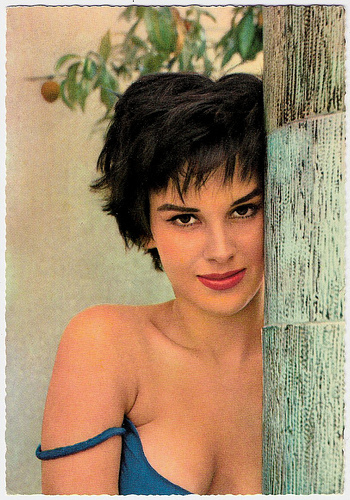
German postcard by Krüger/Ufa, no. 902/151. Photo: Fried Agency.
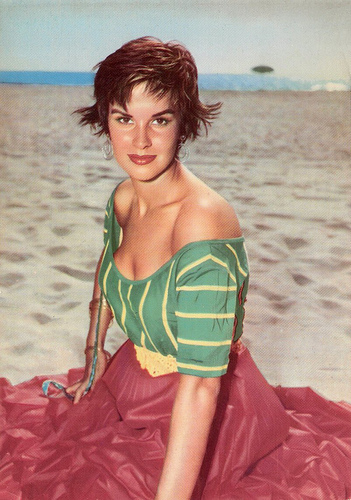
French postcard by Editions P.I., Paris (French licency holder for Ufa, Berlin-Tempelhof), no. CK-159. Photo: Herbert Fried / Ufa.
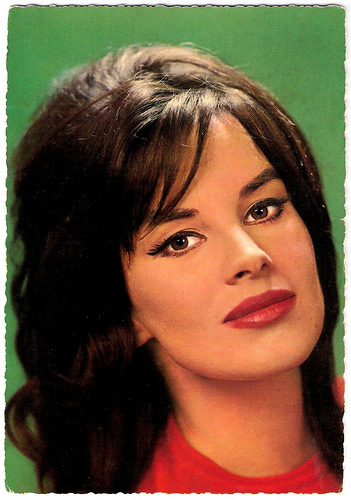
German postcard by Krüger, no. 902/111. Photo: Farabola.
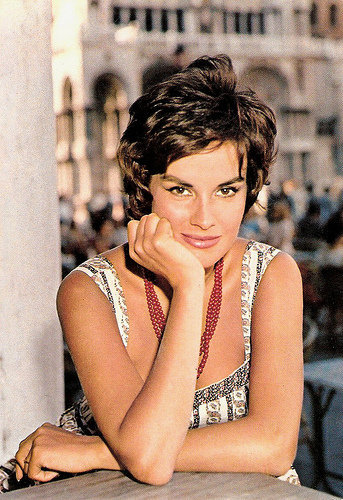
Italian postcard by Rotalfoto, Milano (Milan), no. 62.
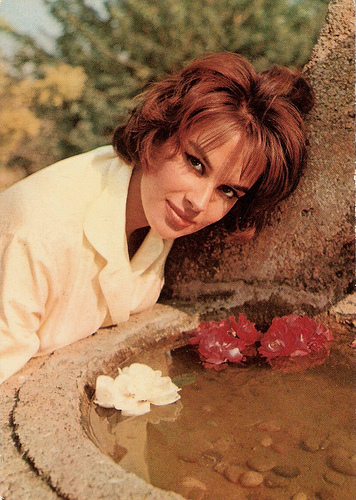
French postcard by Editions P.I., Paris, no. 1032. Photo: Beauvarlet / D. Roger.
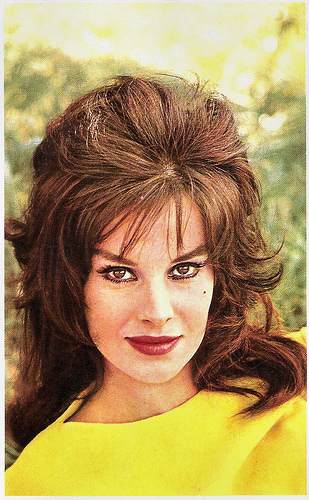
French postcard by Editions P.I., Paris, offered by Corvisart, no. 1072. Photo: Noa.
Franco Interlenghi
Antonella Lualdi was born as Antonietta De Pascale in Beirut, Lebanon in 1931. She was the daughter of an Italian civil engineer and his Greek wife. She learned to speak Italian, French, Greek and a bit of Arabic.
With her mother, her sister and her two brothers, Antonella went to live in Rome. At 17, she made her film debut in the musical Signorinella (Mario Mattoli, 1949).
That same year, she appeared in Canzoni per le strade/Songs for the Road (Mario Landi, 1949). Immediately she was seen as a star of the same stature as Lucia Bosé and Gina Lollobrigida .
In the early 1950,s she appeared successfully in films like Ha fatto 13 (Carlo Manzoni, 1951), E Più Facile Che Un Camello/It is Easier for a Camel (Luigi Zampa, 1951) with Jean Gabin , La cieca di Sorrento/The Blind Woman from Sorrento (Giacomo Gentilomo, 1952), the comedy È arrivato l'accordatore/The Piano Tuner Has Arrived (Duilio Coletti, 1952), and Il cappotto/The Overcoat (Alberto Lattuada, 1952) - an adaptation of the classic Nicolas Gogol fable.
During the shooting of I Vitelloni (Federico Fellini, 1953), she met her future husband, Franco Interlenghi .
Together they starred in several productions like Non c'è amore più grande (Giorgio Bianchi, 1955), Gli innamorati/Wild Love (Mauro Bolognini, 1955), which was feted at the 1956 Cannes Film Festival, and Padri e figli/Fathers and Sons (Mario Monicelli, 1957).
Without her husband, she appeared opposite Marcello Mastroianni in the controversial Cronache di poveri amanti/Chronicle of Poor Lovers (Carlo Lizzani, 1954), La notte brava/The Big Night (Mauro Bolognini, 1959), I delfini/The Dauphins (Francesco Maselli, 1960) starring Claudia Cardinale , and Il disordine/Disorder (Franco Brusati, 1962) with Alida Valli .
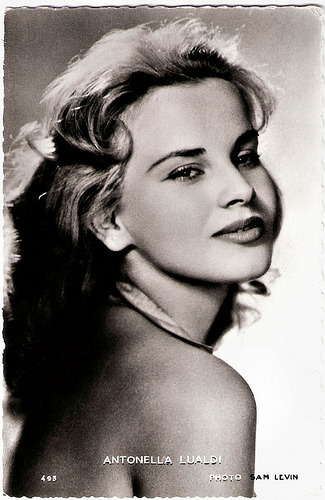
French postcard by Editions P.I., Paris, no. 493. Photo: Sam Lévin.
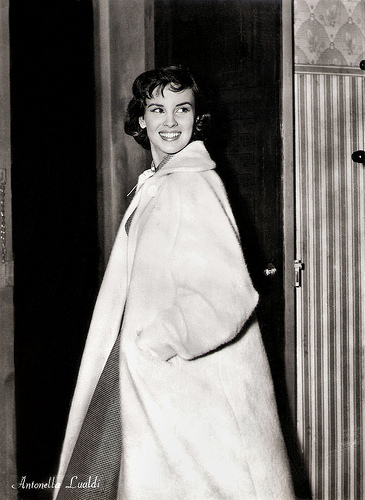
Big Italian postcard by Bromofoto, Milano.
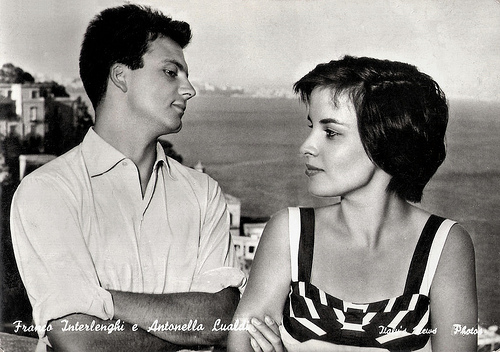
Italian postcard by Bromofoto, Milano, no. 1234. Photo: Italy's News Photos. With Franco Interlenghi .
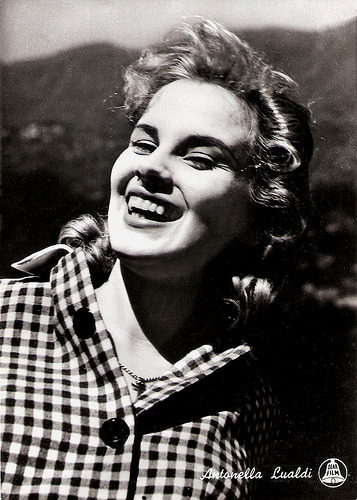
Italian postcard by Bromofoto, no. 550. Photo: Dear Film.
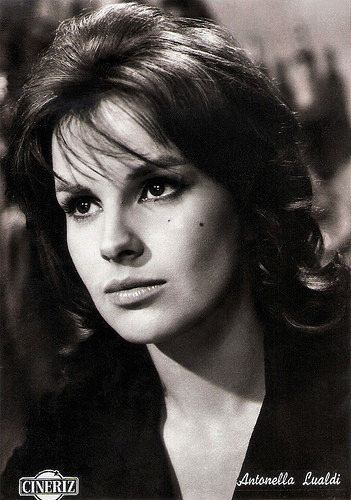
Italian postcard by Bromofoto, Milano, no. 1736. Photo: Cineriz. Publicity still for Via Margutta/Run with the Devil (Mario Camerini, 1960).
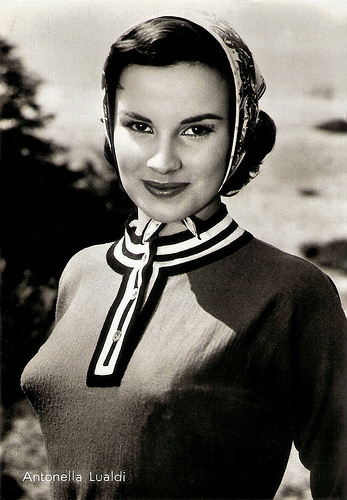
Italian postcard by Bromostampa, no. 6.
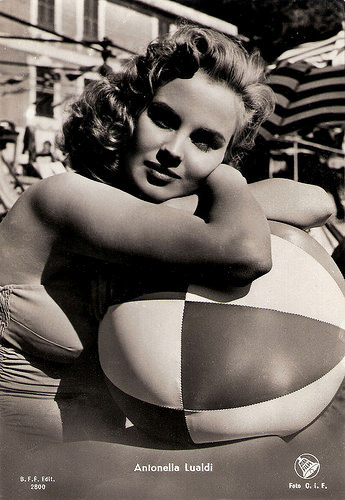
Italian postcard by B.F.F. Edit., no. 2800. Photo: Dear Film / C.I.F.
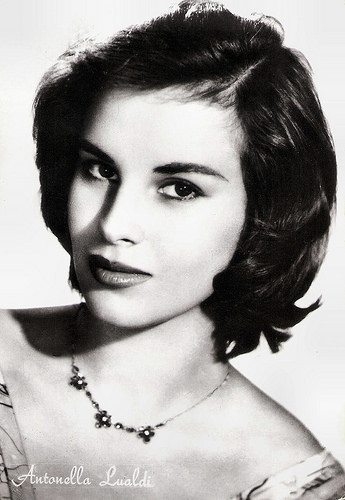
Yugoslavian postcard by NPO, no. G21.
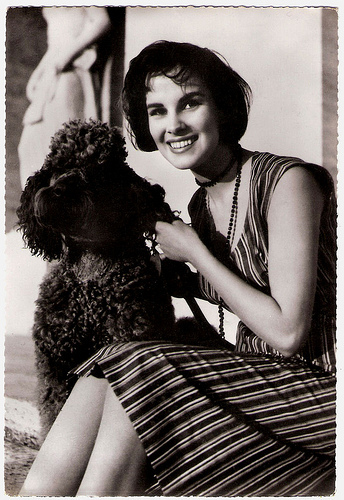
Yugoslavian postcard by 3K, no. 3840.
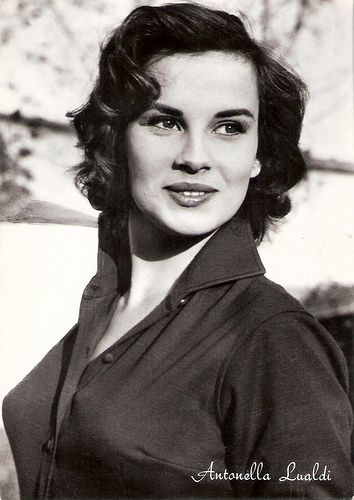
Italian postcard by Rotalfoto, no. 539.
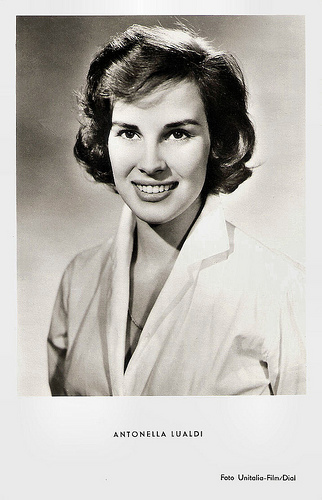
West-German postcard by Kunst und Bild, Berlin, no. A 1155. Photo: Unitalia-Film / Dial.
Arthouse and Sword and Sandal Epics
Antonella Lualdi appeared also in many French films, including Adorable créatures (Christian-Jaque, 1952) with Daniel Gélin , the successful Stendhal adaptation Le Rouge et le Noir/The Red and the Black (Claude Autant-Lara, 1954) starring Gérard Philipe , the Film-Noir Mefiez-Vous Fillettes/Look Out Girls (Yves Allégret, 1957), Une Vie/A Life (Alexandre Astruc, 1958) based on a novel by Guy De Mauppasant, and Á Double Tour/Web of Passion (1959), a tale of murder and a dysfunctional family by Nouvelle Vague director Claude Chabrol.
In the 1960s she was seen in arthouse productions like Se permettete parliamo di donne/Let's Talk About Women (Ettore Scola, 1964) with Vittorio Gassman , Comizi d'amore (Pier Paolo Pasolini, 1965), and Made in Italy (Nanni Loy, 1965).
But she also starred in Sword and Sandal epics like Arrivano i Titani/The Titans (Duccio Tessari, 1961), I cento cavalieri/Hundred Horsemen (Vittorio Cottafavi, 1964), and Columna/The Column (Mircea Dragan, 1968) with Richard Johnson and the legendary Amedeo Nazzari .
From the 1970s on, her films were less interesting with the exception of Vincent, François, Paul et les Autres/Vincent, Francois, Paul and the Others (Claude Sautet, 1974). For a while she worked as an assistant director.
In 1992 she made a come-back on TV as Lucia Cordier, the wife of the protagonist (Pierre Mondy) of the crime series Les Cordier, juge et flic, which was broadcasted for 13 seasons till 2005. Her role was continued in the series Commissaire Cordier (2005-2008).
Antonella Lualdi and Franco Interlenghi separated in 1972, but later came back together. Interlenghi passed away in 2015. They had two daughters, Stella Interlenghi and actress Antonella Interlenghi.
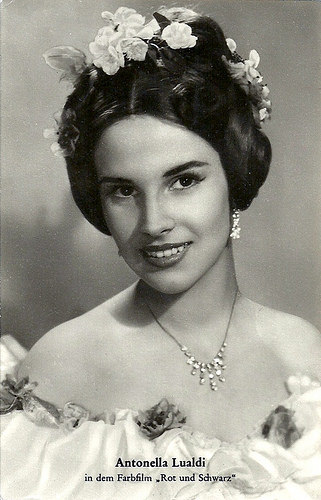
East-German postcard by VEB Progress Filmvertrieb, Berlin. Photo: Antonella Lualdi in Le rouge et le noir (Claude Autant-Lara, 1954).
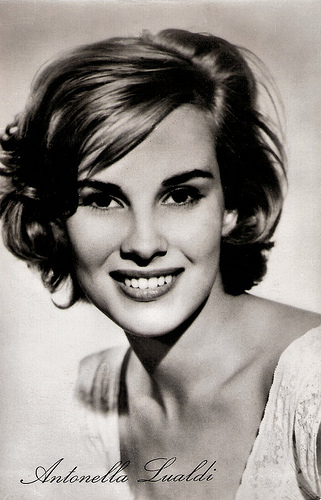
East-German postcard by VEB Progress Film-Vertrieb, no. 836, 1959.
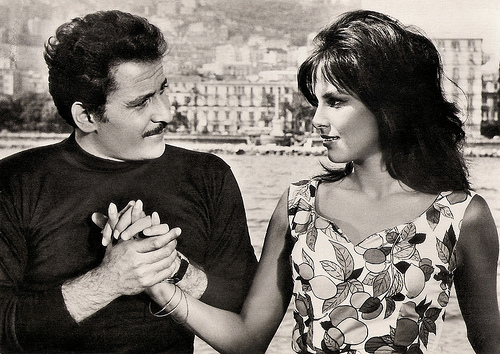
East-German postcard by VEB Progress Filmvertrieb, Berlin. Photo: Antonella Lualdi and Domenico Modugno in Appuntamento a Ischia (Mario Mattoli, 1960).
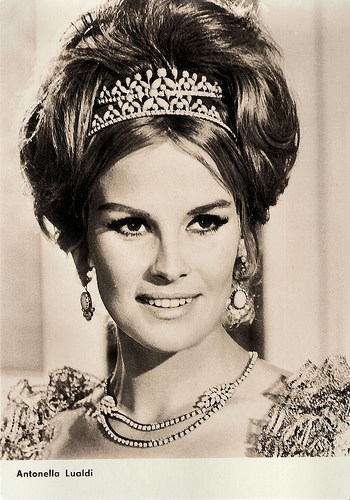
East-German postcard by VEB Progress Film-Vertrieb, Berlin, no. 2815, 1967. Photo: publicity still for Surcouf, l'eroe dei sette mari/The Sea Pirate (Sergio Bergonzelli, Roy Rowland, 1966).
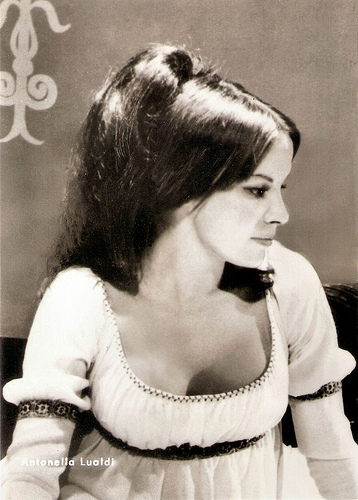
East-German postcard by VEB Progress Film-Vertrieb, Berlin, no. 248/70. Photo: publicity still for Columna/Trajan's Column (Mircea Dragan, 1968).
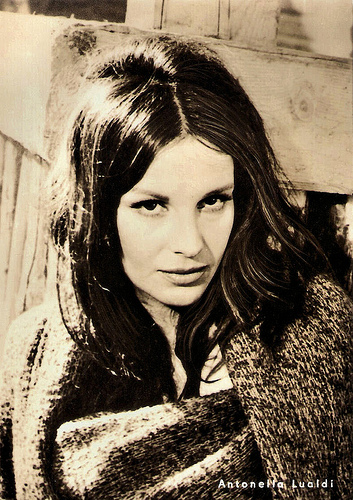
East-German postcard by VEB Progress Film-Vertrieb, no. 20/71. Photo: publicity still for Columna/The Column (Mircea Dragan, 1968).
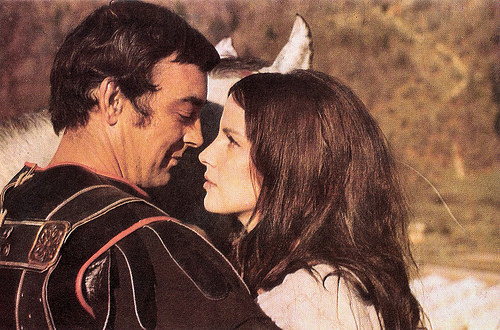
Romanian postcard by Casa Filmului Acin, no. 92. Photo: publicity still for Columna/Trajan's Column (Mircea Dragan, 1968) with Richard Johnson .

French postcard in the series 'Les Cordier, juge et flic - Le collection officielle' by U.M.K. Collections, 2004. Photo: Corbis. Publicity still for Les Cordier, juge et flic/The Cordiers, Judge and Cop (1992-2005) with Antonella Lualdi as Lucia Cordier.
Sources: Sandra Brennan (AllMovie), Notre Cinema (French), Wikipedia, and .

German postcard by Krüger/Ufa, no. 902/151. Photo: Fried Agency.

French postcard by Editions P.I., Paris (French licency holder for Ufa, Berlin-Tempelhof), no. CK-159. Photo: Herbert Fried / Ufa.

German postcard by Krüger, no. 902/111. Photo: Farabola.

Italian postcard by Rotalfoto, Milano (Milan), no. 62.

French postcard by Editions P.I., Paris, no. 1032. Photo: Beauvarlet / D. Roger.

French postcard by Editions P.I., Paris, offered by Corvisart, no. 1072. Photo: Noa.
Franco Interlenghi
Antonella Lualdi was born as Antonietta De Pascale in Beirut, Lebanon in 1931. She was the daughter of an Italian civil engineer and his Greek wife. She learned to speak Italian, French, Greek and a bit of Arabic.
With her mother, her sister and her two brothers, Antonella went to live in Rome. At 17, she made her film debut in the musical Signorinella (Mario Mattoli, 1949).
That same year, she appeared in Canzoni per le strade/Songs for the Road (Mario Landi, 1949). Immediately she was seen as a star of the same stature as Lucia Bosé and Gina Lollobrigida .
In the early 1950,s she appeared successfully in films like Ha fatto 13 (Carlo Manzoni, 1951), E Più Facile Che Un Camello/It is Easier for a Camel (Luigi Zampa, 1951) with Jean Gabin , La cieca di Sorrento/The Blind Woman from Sorrento (Giacomo Gentilomo, 1952), the comedy È arrivato l'accordatore/The Piano Tuner Has Arrived (Duilio Coletti, 1952), and Il cappotto/The Overcoat (Alberto Lattuada, 1952) - an adaptation of the classic Nicolas Gogol fable.
During the shooting of I Vitelloni (Federico Fellini, 1953), she met her future husband, Franco Interlenghi .
Together they starred in several productions like Non c'è amore più grande (Giorgio Bianchi, 1955), Gli innamorati/Wild Love (Mauro Bolognini, 1955), which was feted at the 1956 Cannes Film Festival, and Padri e figli/Fathers and Sons (Mario Monicelli, 1957).
Without her husband, she appeared opposite Marcello Mastroianni in the controversial Cronache di poveri amanti/Chronicle of Poor Lovers (Carlo Lizzani, 1954), La notte brava/The Big Night (Mauro Bolognini, 1959), I delfini/The Dauphins (Francesco Maselli, 1960) starring Claudia Cardinale , and Il disordine/Disorder (Franco Brusati, 1962) with Alida Valli .

French postcard by Editions P.I., Paris, no. 493. Photo: Sam Lévin.

Big Italian postcard by Bromofoto, Milano.

Italian postcard by Bromofoto, Milano, no. 1234. Photo: Italy's News Photos. With Franco Interlenghi .

Italian postcard by Bromofoto, no. 550. Photo: Dear Film.

Italian postcard by Bromofoto, Milano, no. 1736. Photo: Cineriz. Publicity still for Via Margutta/Run with the Devil (Mario Camerini, 1960).

Italian postcard by Bromostampa, no. 6.

Italian postcard by B.F.F. Edit., no. 2800. Photo: Dear Film / C.I.F.

Yugoslavian postcard by NPO, no. G21.

Yugoslavian postcard by 3K, no. 3840.

Italian postcard by Rotalfoto, no. 539.

West-German postcard by Kunst und Bild, Berlin, no. A 1155. Photo: Unitalia-Film / Dial.
Arthouse and Sword and Sandal Epics
Antonella Lualdi appeared also in many French films, including Adorable créatures (Christian-Jaque, 1952) with Daniel Gélin , the successful Stendhal adaptation Le Rouge et le Noir/The Red and the Black (Claude Autant-Lara, 1954) starring Gérard Philipe , the Film-Noir Mefiez-Vous Fillettes/Look Out Girls (Yves Allégret, 1957), Une Vie/A Life (Alexandre Astruc, 1958) based on a novel by Guy De Mauppasant, and Á Double Tour/Web of Passion (1959), a tale of murder and a dysfunctional family by Nouvelle Vague director Claude Chabrol.
In the 1960s she was seen in arthouse productions like Se permettete parliamo di donne/Let's Talk About Women (Ettore Scola, 1964) with Vittorio Gassman , Comizi d'amore (Pier Paolo Pasolini, 1965), and Made in Italy (Nanni Loy, 1965).
But she also starred in Sword and Sandal epics like Arrivano i Titani/The Titans (Duccio Tessari, 1961), I cento cavalieri/Hundred Horsemen (Vittorio Cottafavi, 1964), and Columna/The Column (Mircea Dragan, 1968) with Richard Johnson and the legendary Amedeo Nazzari .
From the 1970s on, her films were less interesting with the exception of Vincent, François, Paul et les Autres/Vincent, Francois, Paul and the Others (Claude Sautet, 1974). For a while she worked as an assistant director.
In 1992 she made a come-back on TV as Lucia Cordier, the wife of the protagonist (Pierre Mondy) of the crime series Les Cordier, juge et flic, which was broadcasted for 13 seasons till 2005. Her role was continued in the series Commissaire Cordier (2005-2008).
Antonella Lualdi and Franco Interlenghi separated in 1972, but later came back together. Interlenghi passed away in 2015. They had two daughters, Stella Interlenghi and actress Antonella Interlenghi.

East-German postcard by VEB Progress Filmvertrieb, Berlin. Photo: Antonella Lualdi in Le rouge et le noir (Claude Autant-Lara, 1954).

East-German postcard by VEB Progress Film-Vertrieb, no. 836, 1959.

East-German postcard by VEB Progress Filmvertrieb, Berlin. Photo: Antonella Lualdi and Domenico Modugno in Appuntamento a Ischia (Mario Mattoli, 1960).

East-German postcard by VEB Progress Film-Vertrieb, Berlin, no. 2815, 1967. Photo: publicity still for Surcouf, l'eroe dei sette mari/The Sea Pirate (Sergio Bergonzelli, Roy Rowland, 1966).

East-German postcard by VEB Progress Film-Vertrieb, Berlin, no. 248/70. Photo: publicity still for Columna/Trajan's Column (Mircea Dragan, 1968).

East-German postcard by VEB Progress Film-Vertrieb, no. 20/71. Photo: publicity still for Columna/The Column (Mircea Dragan, 1968).

Romanian postcard by Casa Filmului Acin, no. 92. Photo: publicity still for Columna/Trajan's Column (Mircea Dragan, 1968) with Richard Johnson .

French postcard in the series 'Les Cordier, juge et flic - Le collection officielle' by U.M.K. Collections, 2004. Photo: Corbis. Publicity still for Les Cordier, juge et flic/The Cordiers, Judge and Cop (1992-2005) with Antonella Lualdi as Lucia Cordier.
Sources: Sandra Brennan (AllMovie), Notre Cinema (French), Wikipedia, and .
Published on July 12, 2018 22:00
July 11, 2018
Die Fahrt ins Blaue (1919)
Henny Porten starred in the German silent comedy Die Fahrt ins Blaue/The drive into the blue (Rudolf Biebrach, 1919). Her co-star was Georg Alexander. The film was produced by Messter-film and Projektions-AG Union (PAGU) and was scripted by Hanns Kräly and cinematographed by Willy Gaebel.
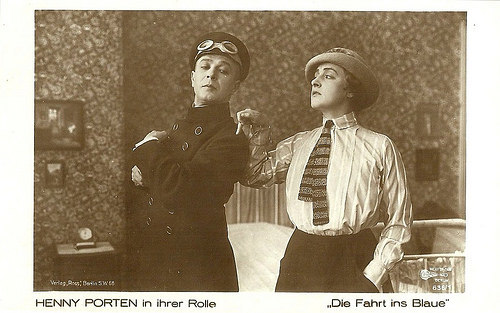
German postcard by Ross Verlag, no. 636/1. Photo: Messter Film. Henny Porten and Georg Alexander in Die Fahrt ins Blaue (Rudolf Biebrach, 1919).
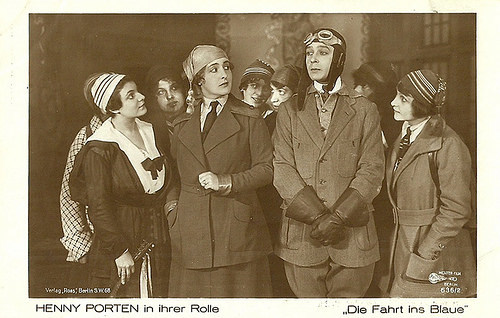
German postcard by Ross Verlag, no. 636/2. Photo: Messter Film. Henny Porten and Georg Alexander in Die Fahrt ins Blaue (Rudolf Biebrach, 1919).
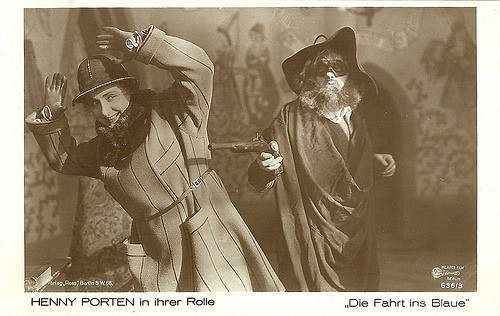
German postcard by Ross Verlag, no. 636/3. Photo: Messter Film. Henny Porten in Die Fahrt ins Blaue (Rudolf Biebrach, 1919).
An alarm clock for her birthday
In the silent German comedy Die Fahrt ins Blaue (Rudolf Biebrach, 1919), Henny Porten plays Cashier Wanda Lossen, who gets an alarm clock and a lottery ticket for her birthday. The lottery's main award is a fancy touring car and 20,000 Marks.
At the same time writer Dr. Erich Fuld ( Georg Alexander ) visits his new possession, an old castle. The next morning Wanda's new alarm doesn't go off, so in haste Wanda bumps onto Fuld on a street corner, who likes her and follows her.
Wanda bursts into tears when her boss at the store, herr Paetz (Jakob Tiedtke), reprimands her, but Paetz then falls in love with her, promising her a life of luxury. Offended she waves the lottery ticket, telling him that soon she'll manage on her own.
During a visit to Erich's castle with her friends, Erich jokingly manages to tie Wanda up to some old folter instrument. She offers her lottery ticket as ransom, but instead he steals her a kiss. Once freed she gives him a mighty slap in return.
One day she hears she has won the lottery and that the car is just outside, but she gets the car only on the condition that she also overtakes a chauffeur for three months, until the car is ready. Of course Erich is the driver. After a party in an inn with her friends, Erich pretends a breakdown on the road back and goes for help.
While he is away, masked bandits - Erich's servants, in fact - assault Wanda. Erich saves her and leads her with his car 'ins Blaue' (into the blue, meaning where chance will lead them).
Die Fahrt ins Blaue/The drive into the blue (Rudolf Biebrach, 1919) premiered on 21 November 1919 in the Mozartsaal Berlin. The film was distributed in Germany by Hansa Film Verleih and Universum Film (UFA).
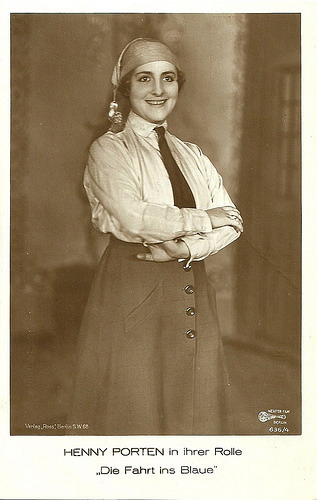
German postcard by Ross Verlag, no. 636/4. Photo: Messter Film. Henny Porten in Die Fahrt ins Blaue (Rudolf Biebrach, 1919).
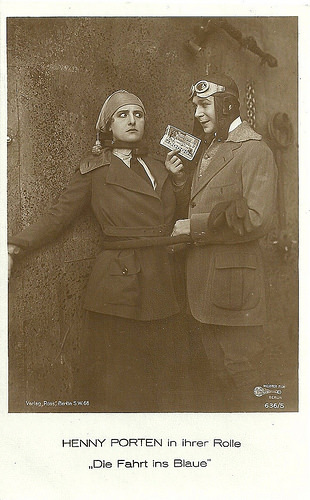
German postcard by Ross Verlag, no. 636/5. Photo: Messter Film. Henny Porten and Georg Alexander in Die Fahrt ins Blaue (Rudolf Biebrach, 1919).
Sources: Murnau-stiftung, IMDb and Wikipedia (Italian).

German postcard by Ross Verlag, no. 636/1. Photo: Messter Film. Henny Porten and Georg Alexander in Die Fahrt ins Blaue (Rudolf Biebrach, 1919).

German postcard by Ross Verlag, no. 636/2. Photo: Messter Film. Henny Porten and Georg Alexander in Die Fahrt ins Blaue (Rudolf Biebrach, 1919).

German postcard by Ross Verlag, no. 636/3. Photo: Messter Film. Henny Porten in Die Fahrt ins Blaue (Rudolf Biebrach, 1919).
An alarm clock for her birthday
In the silent German comedy Die Fahrt ins Blaue (Rudolf Biebrach, 1919), Henny Porten plays Cashier Wanda Lossen, who gets an alarm clock and a lottery ticket for her birthday. The lottery's main award is a fancy touring car and 20,000 Marks.
At the same time writer Dr. Erich Fuld ( Georg Alexander ) visits his new possession, an old castle. The next morning Wanda's new alarm doesn't go off, so in haste Wanda bumps onto Fuld on a street corner, who likes her and follows her.
Wanda bursts into tears when her boss at the store, herr Paetz (Jakob Tiedtke), reprimands her, but Paetz then falls in love with her, promising her a life of luxury. Offended she waves the lottery ticket, telling him that soon she'll manage on her own.
During a visit to Erich's castle with her friends, Erich jokingly manages to tie Wanda up to some old folter instrument. She offers her lottery ticket as ransom, but instead he steals her a kiss. Once freed she gives him a mighty slap in return.
One day she hears she has won the lottery and that the car is just outside, but she gets the car only on the condition that she also overtakes a chauffeur for three months, until the car is ready. Of course Erich is the driver. After a party in an inn with her friends, Erich pretends a breakdown on the road back and goes for help.
While he is away, masked bandits - Erich's servants, in fact - assault Wanda. Erich saves her and leads her with his car 'ins Blaue' (into the blue, meaning where chance will lead them).
Die Fahrt ins Blaue/The drive into the blue (Rudolf Biebrach, 1919) premiered on 21 November 1919 in the Mozartsaal Berlin. The film was distributed in Germany by Hansa Film Verleih and Universum Film (UFA).

German postcard by Ross Verlag, no. 636/4. Photo: Messter Film. Henny Porten in Die Fahrt ins Blaue (Rudolf Biebrach, 1919).

German postcard by Ross Verlag, no. 636/5. Photo: Messter Film. Henny Porten and Georg Alexander in Die Fahrt ins Blaue (Rudolf Biebrach, 1919).
Sources: Murnau-stiftung, IMDb and Wikipedia (Italian).
Published on July 11, 2018 22:00
July 10, 2018
Genia Nikolaieva
Russian-born ballet dancer and actress Genia Nikolaieva (1904–2001) worked in the Germany cinema during the 1930s. In 1938 she emigrated to the United States, where she became ‘one of the most beautiful studio secretaries for Warner Bros.
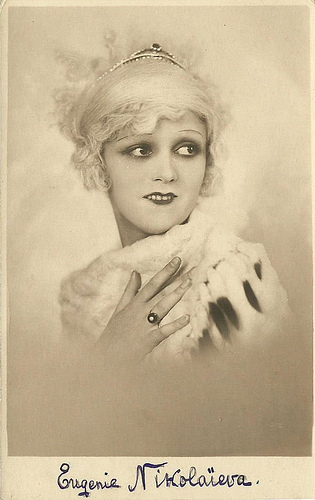
German postcard by Gabor Hirsch, Frankfurt. Photo: Gabor Hirsch. Collection: Didier Hanson. This card was in Nikolaieva's suitcase full of personal documents, including her passport. After her death, her friend and will curator sold it to Didier.
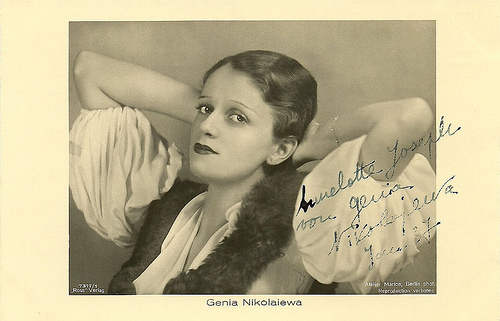
German postcard by Ross Verlag, no. 7317/1, 1932-1933. Photo: Atelier Marion, Berlin. Collection: Didier Hanson.
The State Opera Six
Genia Nikolaieva was born in St Petersburg, Russia in 1904. Her name is also written as Genia Nikolajeva, Eugenia Nikolajewa or Genia Nikolaiewa.
Her parents moved to Berlin where she took ballet lessons. In 1920 she had her first professional dance performance. She continued her dance career at the Stadttheater Königsberg and she danced in the ensemble of Ernst Matráy , and with his company she gave guest performances in England and South America.
She became one of the soloists at the Deutschen Staatsoper ballet (German State Opera Ballet) in Berlin. In 1930 she and five other soloists were dismissed by the director of ballet, the innovative choreographer and dance theoretic Rudolf von Laban, because they belonged to the ‘ballet camp’ and not to his ‘modern dance’ camp.
The dismissed dancers, the ’State Opera Six’, generated much publicity in the press. They successfully appeared at dance evenings and variety shows with their popular and well-established repertoire.
Nikolaieva also started a film career. Her film debut was in Zwei Krawatten/Two Neckties (Felix Basch, Richard Weichert, 1930) starring Olga Tschechova . She appeared in the slapstick comedy Schuetzenfest in Schilda/Festival of Riflemen in Schilda (Adolf Trotz, 1931) starring Siegfried Arno (aka Sig Arno).
She played in another comedy Ein Toller Einfall/A Mad Idea (Kurt Gerron, 1932) which featured comic actor Max Adelbert and Willy Fritsch . She also had small parts in the crime drama Schuss im Morgengrauen/A Shot at Dawn (Alfred Zeisler, 1932) with Ery Bos , and the stylish farce Quick (Robert Siodmak, 1932) with Hans Albers and Lilian Harvey .
In Das häßliche Mädchen/The ugly girl (Hermann Kosterlitz a.k.a. Henry Koster, 1933) she appeared with Dolly Haas and Max Hansen . It was the last film that Henry Koster directed in Berlin before having to leave due to Nazis. He left Berlin, having knocked out an SS officer, one day before filming was finished on the film. The Nazis removed his name from the credits and substituted the name of Hasse Preiss, the lyricist.
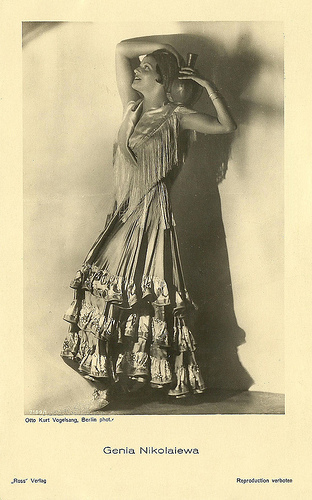
German postcard by Ross Verlag, no. 7189/1, 1932-1933. Photo: Otto Kurt Vogelsang, Berlin. Collection: Didier Hanson.
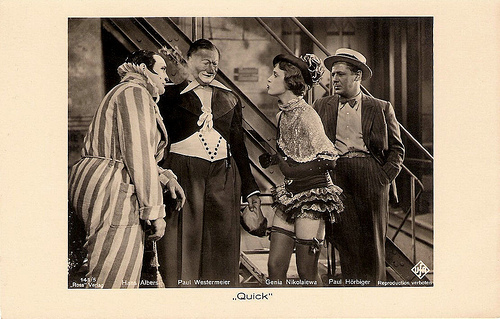
German postcard by Ross Verlag, no. 141/5, 1931-1932. Photo: Ufa. Publicity still for Quick (Robert Siodmak, 1931) in which Hans Albers played the title role.
'Northern'
From 1933 on, Genia Nikolaieva found it difficult to continue working under the new Nazi regime because of the now asked Aryan certificate. Propaganda minister Joseph Goebbels spoke up for her and pinned the half-Jewess officially as ‘northern’.
She played the female lead in 90 Minuten Aufenthalt/90 Minutes Stop (Harry Piel, 1934) starring Harry Piel , but mostly she played supporting parts such as in the comedies Das Einmaleins der Liebe/Love's Arithmetic (Carl Hoffmann) with Luise Ullrich , and Ein Ganzer Kerl/A Regular Fellow (Carl Boese, 1936) with Hermann Speelmans en Lien Deyers .
She also appeared with the Swedish comedy team of Fy og Bi aka Pat & Patachon in the goofy comedy Blinde Passagiere/Stowaways (Fred Sauer, 1937).
Her final European films were Meine Frau, die Perle/My Wife – the Pearl (Alwin Elling, 1937) with Ralph Arthur Roberts , and Unentschuldigte Stunde/The Unexcused Hour (E.W. Emo, 1937) with Hans Moser .
In 1938 she emigrated to the United States. In Hollywood she only appeared in small parts in three films: Ride a Crooked Mile (Alfred E. Green, 1938), Adventure in Diamonds (George Fitzmaurice, 1940) with Isa Miranda , and The Lady Has Plans (Sidney Lanfield, 1942). IMDb writes that she then became ‘one of the most beautiful studio secretaries for Warner Bros’.
Genia Nikolaieva died in 2001 in Los Angeles, US. She was 97.
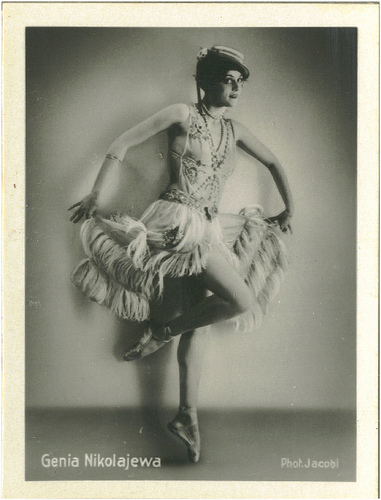
German collectors card by Eckstein, no. 157. Photo: Jacobi. Collection: Manuel Palomino Arjona (Performing Arts).
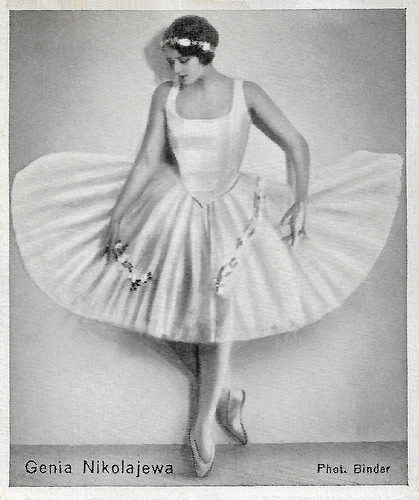
German collectors card by Eckstein-Halpaus, Dresden, Gruppe 4, no. 159. Photo: Alex Binder.
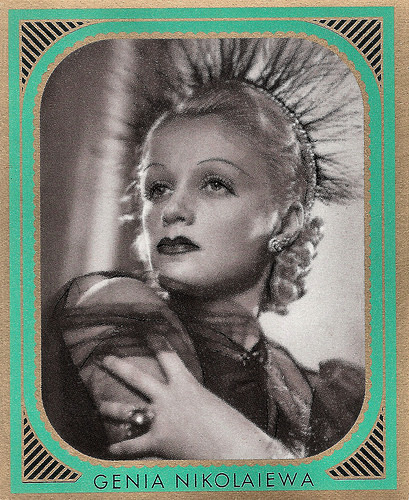
German collectors card in the Bunte Filmbilder series by Greiling-Zigaretten, Series no. 2, no. 358. Photo: Ufa / Ross Verlag.
Sources: Thomas Staedeli (Cyranos), Hal Erickson (AllMovie), Lilian Karina & Marion Kant (Hitler’s Dancers) and .

German postcard by Gabor Hirsch, Frankfurt. Photo: Gabor Hirsch. Collection: Didier Hanson. This card was in Nikolaieva's suitcase full of personal documents, including her passport. After her death, her friend and will curator sold it to Didier.

German postcard by Ross Verlag, no. 7317/1, 1932-1933. Photo: Atelier Marion, Berlin. Collection: Didier Hanson.
The State Opera Six
Genia Nikolaieva was born in St Petersburg, Russia in 1904. Her name is also written as Genia Nikolajeva, Eugenia Nikolajewa or Genia Nikolaiewa.
Her parents moved to Berlin where she took ballet lessons. In 1920 she had her first professional dance performance. She continued her dance career at the Stadttheater Königsberg and she danced in the ensemble of Ernst Matráy , and with his company she gave guest performances in England and South America.
She became one of the soloists at the Deutschen Staatsoper ballet (German State Opera Ballet) in Berlin. In 1930 she and five other soloists were dismissed by the director of ballet, the innovative choreographer and dance theoretic Rudolf von Laban, because they belonged to the ‘ballet camp’ and not to his ‘modern dance’ camp.
The dismissed dancers, the ’State Opera Six’, generated much publicity in the press. They successfully appeared at dance evenings and variety shows with their popular and well-established repertoire.
Nikolaieva also started a film career. Her film debut was in Zwei Krawatten/Two Neckties (Felix Basch, Richard Weichert, 1930) starring Olga Tschechova . She appeared in the slapstick comedy Schuetzenfest in Schilda/Festival of Riflemen in Schilda (Adolf Trotz, 1931) starring Siegfried Arno (aka Sig Arno).
She played in another comedy Ein Toller Einfall/A Mad Idea (Kurt Gerron, 1932) which featured comic actor Max Adelbert and Willy Fritsch . She also had small parts in the crime drama Schuss im Morgengrauen/A Shot at Dawn (Alfred Zeisler, 1932) with Ery Bos , and the stylish farce Quick (Robert Siodmak, 1932) with Hans Albers and Lilian Harvey .
In Das häßliche Mädchen/The ugly girl (Hermann Kosterlitz a.k.a. Henry Koster, 1933) she appeared with Dolly Haas and Max Hansen . It was the last film that Henry Koster directed in Berlin before having to leave due to Nazis. He left Berlin, having knocked out an SS officer, one day before filming was finished on the film. The Nazis removed his name from the credits and substituted the name of Hasse Preiss, the lyricist.

German postcard by Ross Verlag, no. 7189/1, 1932-1933. Photo: Otto Kurt Vogelsang, Berlin. Collection: Didier Hanson.

German postcard by Ross Verlag, no. 141/5, 1931-1932. Photo: Ufa. Publicity still for Quick (Robert Siodmak, 1931) in which Hans Albers played the title role.
'Northern'
From 1933 on, Genia Nikolaieva found it difficult to continue working under the new Nazi regime because of the now asked Aryan certificate. Propaganda minister Joseph Goebbels spoke up for her and pinned the half-Jewess officially as ‘northern’.
She played the female lead in 90 Minuten Aufenthalt/90 Minutes Stop (Harry Piel, 1934) starring Harry Piel , but mostly she played supporting parts such as in the comedies Das Einmaleins der Liebe/Love's Arithmetic (Carl Hoffmann) with Luise Ullrich , and Ein Ganzer Kerl/A Regular Fellow (Carl Boese, 1936) with Hermann Speelmans en Lien Deyers .
She also appeared with the Swedish comedy team of Fy og Bi aka Pat & Patachon in the goofy comedy Blinde Passagiere/Stowaways (Fred Sauer, 1937).
Her final European films were Meine Frau, die Perle/My Wife – the Pearl (Alwin Elling, 1937) with Ralph Arthur Roberts , and Unentschuldigte Stunde/The Unexcused Hour (E.W. Emo, 1937) with Hans Moser .
In 1938 she emigrated to the United States. In Hollywood she only appeared in small parts in three films: Ride a Crooked Mile (Alfred E. Green, 1938), Adventure in Diamonds (George Fitzmaurice, 1940) with Isa Miranda , and The Lady Has Plans (Sidney Lanfield, 1942). IMDb writes that she then became ‘one of the most beautiful studio secretaries for Warner Bros’.
Genia Nikolaieva died in 2001 in Los Angeles, US. She was 97.

German collectors card by Eckstein, no. 157. Photo: Jacobi. Collection: Manuel Palomino Arjona (Performing Arts).

German collectors card by Eckstein-Halpaus, Dresden, Gruppe 4, no. 159. Photo: Alex Binder.

German collectors card in the Bunte Filmbilder series by Greiling-Zigaretten, Series no. 2, no. 358. Photo: Ufa / Ross Verlag.
Sources: Thomas Staedeli (Cyranos), Hal Erickson (AllMovie), Lilian Karina & Marion Kant (Hitler’s Dancers) and .
Published on July 10, 2018 22:00
Paul van Yperen's Blog
- Paul van Yperen's profile
- 13 followers
Paul van Yperen isn't a Goodreads Author
(yet),
but they
do have a blog,
so here are some recent posts imported from
their feed.



